Best PTC Filament Drier in 2024: EIBOS Polyphemus vs Creality Space Pi vs SUNLU S4
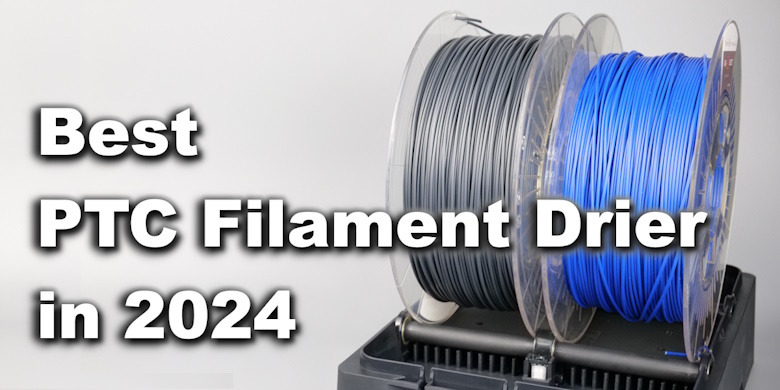
I did not use a lot of different filament driers as I don’t have a humidity problem in the place where I store my filmanent, and most of the time I dry filament in batches using a large oven. But I read a lot of reports online from people mentioning that most of the driers available don’t work as expected due to inaccuracies in the temperature.
Considering that there are a few new PTC Filament Driers that launched recently, I thought it would be a good idea to test them and see which one can be considered “The Best PTC Filament Drier in 2024“.
The battle is between the EIBOS Polyphemus, Creality Space Pi and SUNLU S4.
Why is Filament Drying important?
As mentioned in my How To Dry Your Filament article, the main reason to dry your filament is to have more consistent results during printing. Most of the filaments used in 3D printing are hygroscopic, which means that they absorb moisture from the air and lose some of their proprieties.
Some filaments (PETG, PC, ABS, TPU and Nylon) are more hygroscopic than others (PLA) and to get the best print quality, it’s recommended to dry them before starting a new print.
The contenders
EIBOS Polyphemus
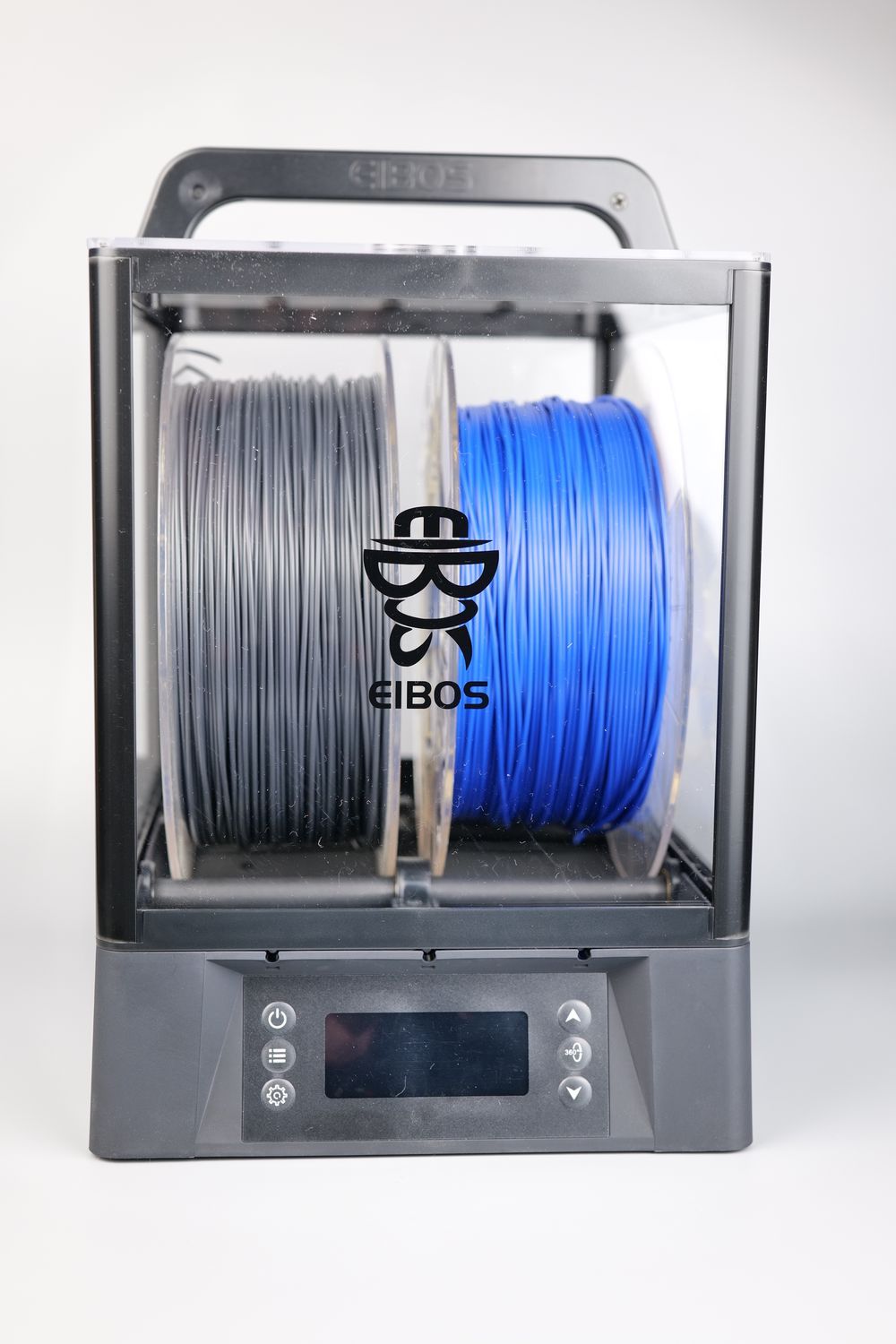
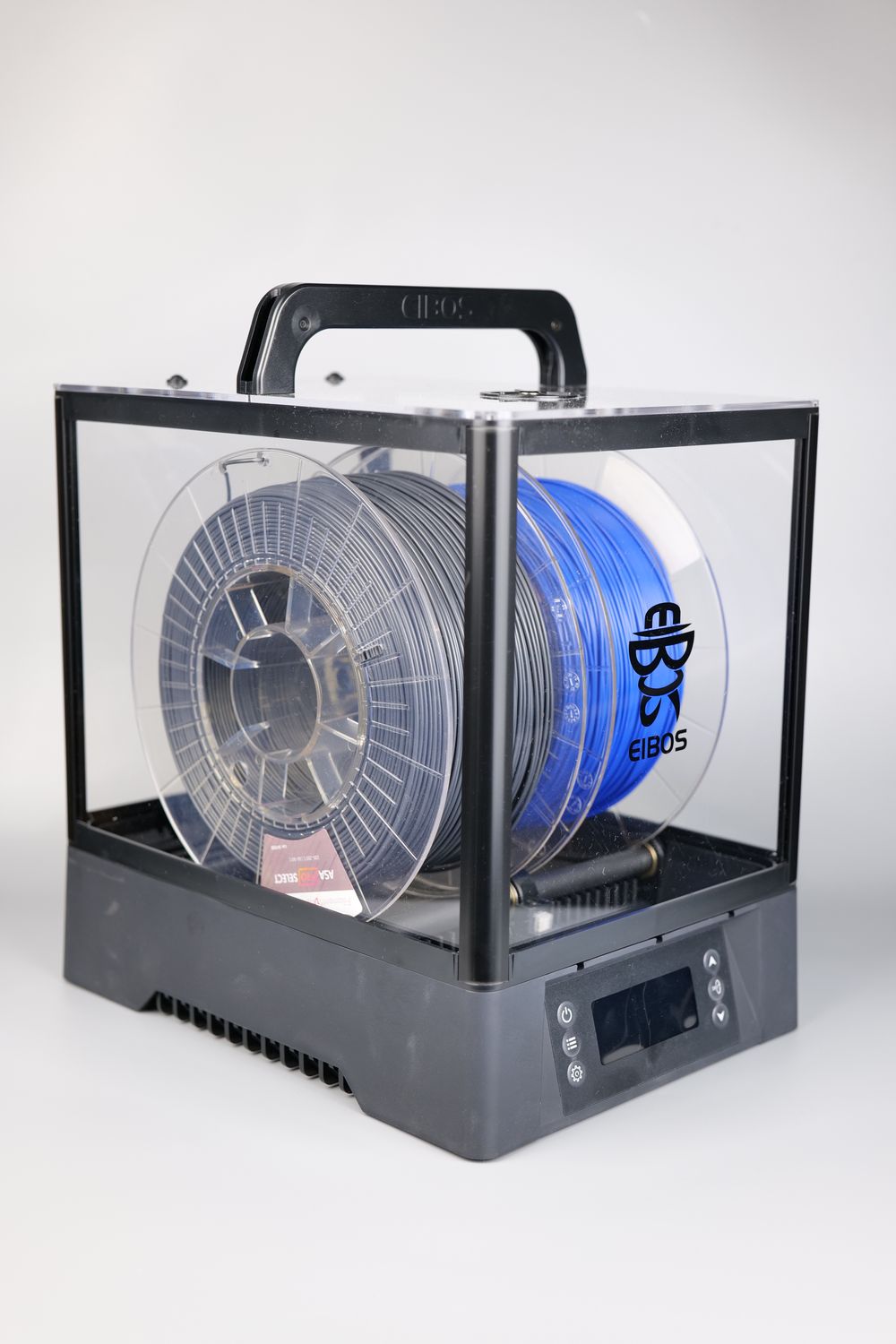
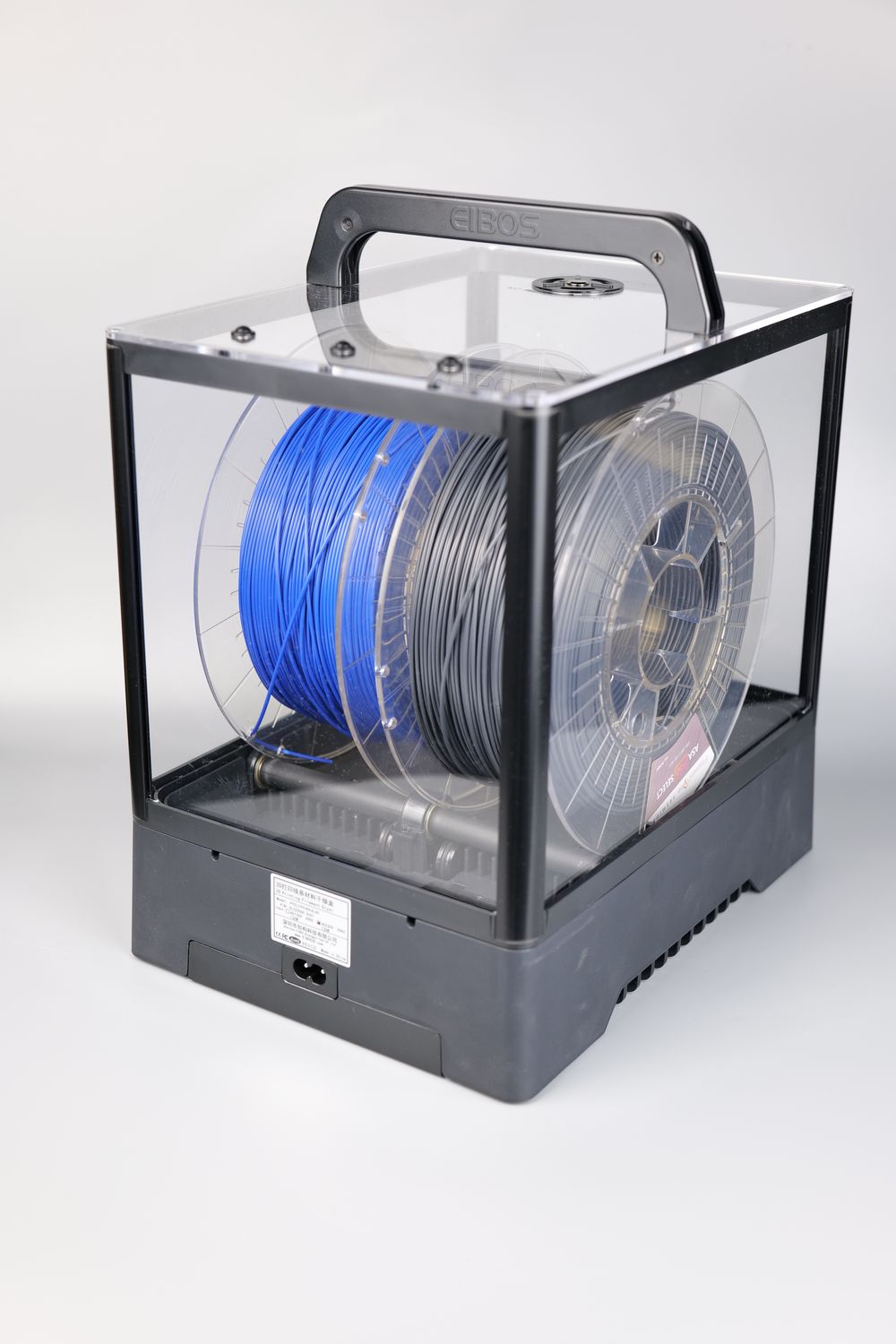
The EIBOS Polyphemus is a dual-spool filament drier which allows you to try 2x1KG rolls of filament or a large 3KG roll. It uses a PTC heater and can reach up to 70C.
Personally, I believe that the most attractive feature of the EIBOS Polyphemus is the spool rotation feature which turns the spools during the drying process, ensuring uniform moisture removal.
| Drying Recommendations | ||
| PLA | 50°C | 4H |
| ABS | 60°C | 2H |
| PETG | 55°C | 2H |
| PA | 70°c | 12H |
| TPU | 60°C | 4H |
| PC | 70°C | 8H |
| ASA | 60°C | 4H |
| PVA | 50°C | 4H |
| PP | 55°C | 6H |
| M1 | 50°C | 4H |
| M2 | 60°C | 8H |
| M3 | 70°C | 12H |
Creality Space Pi
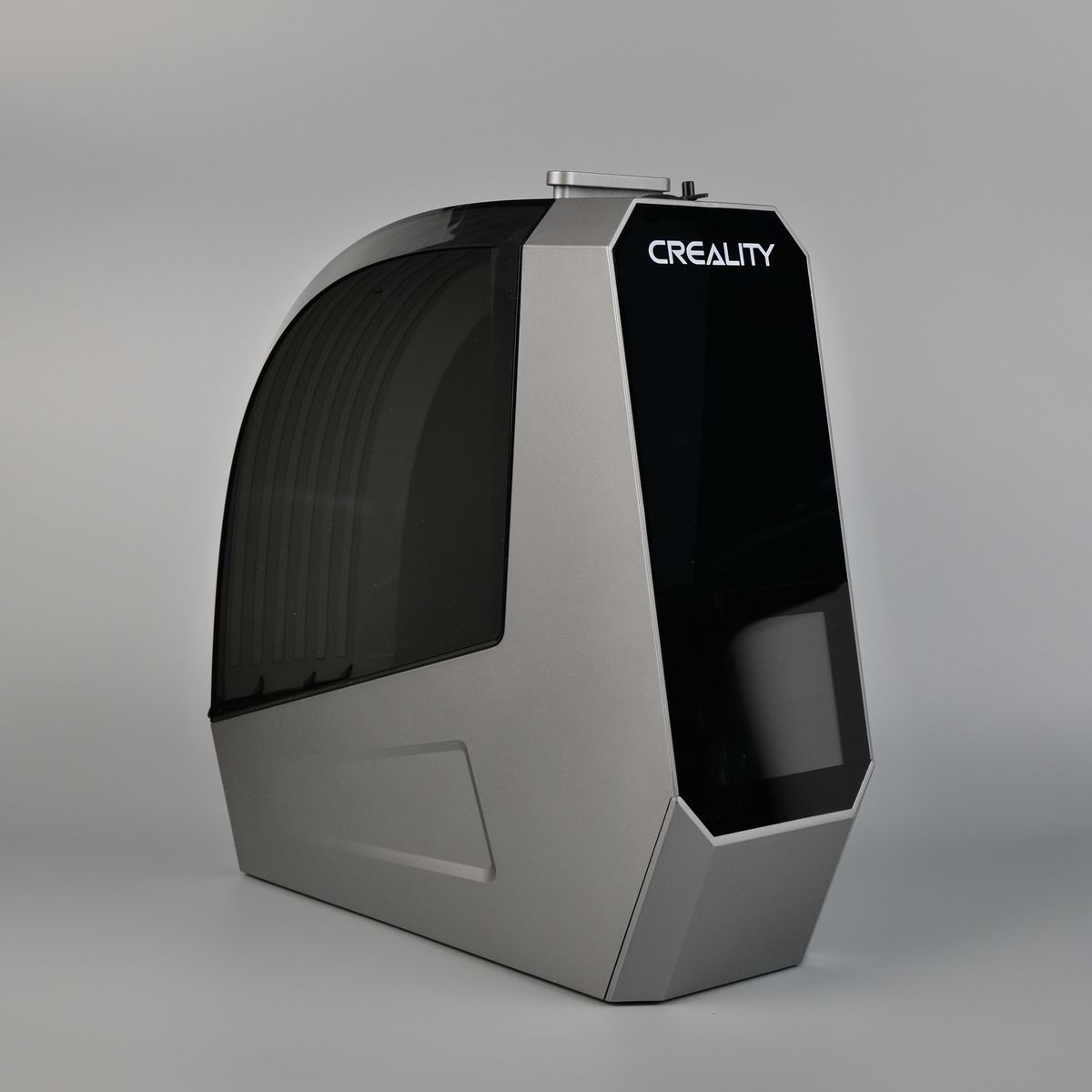
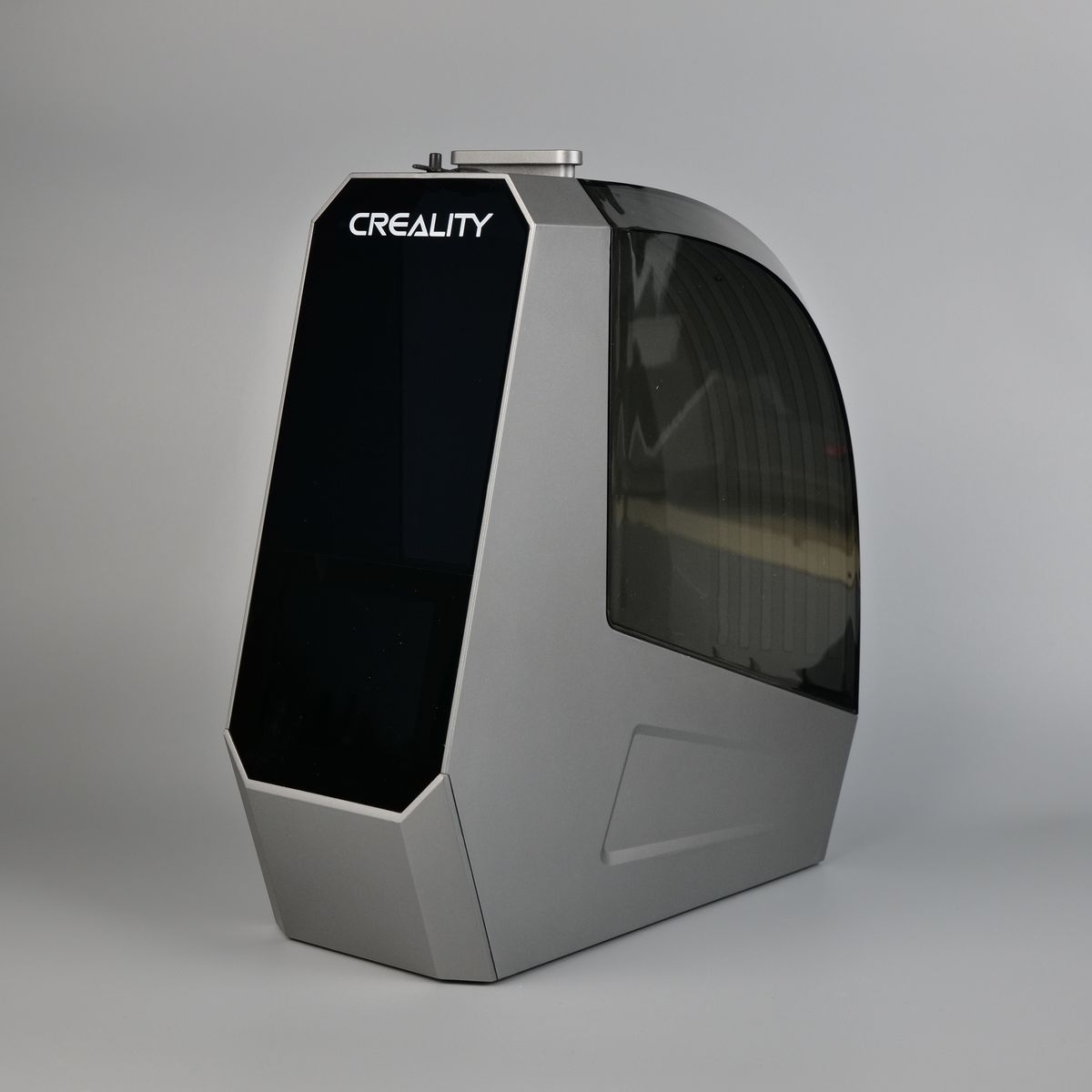
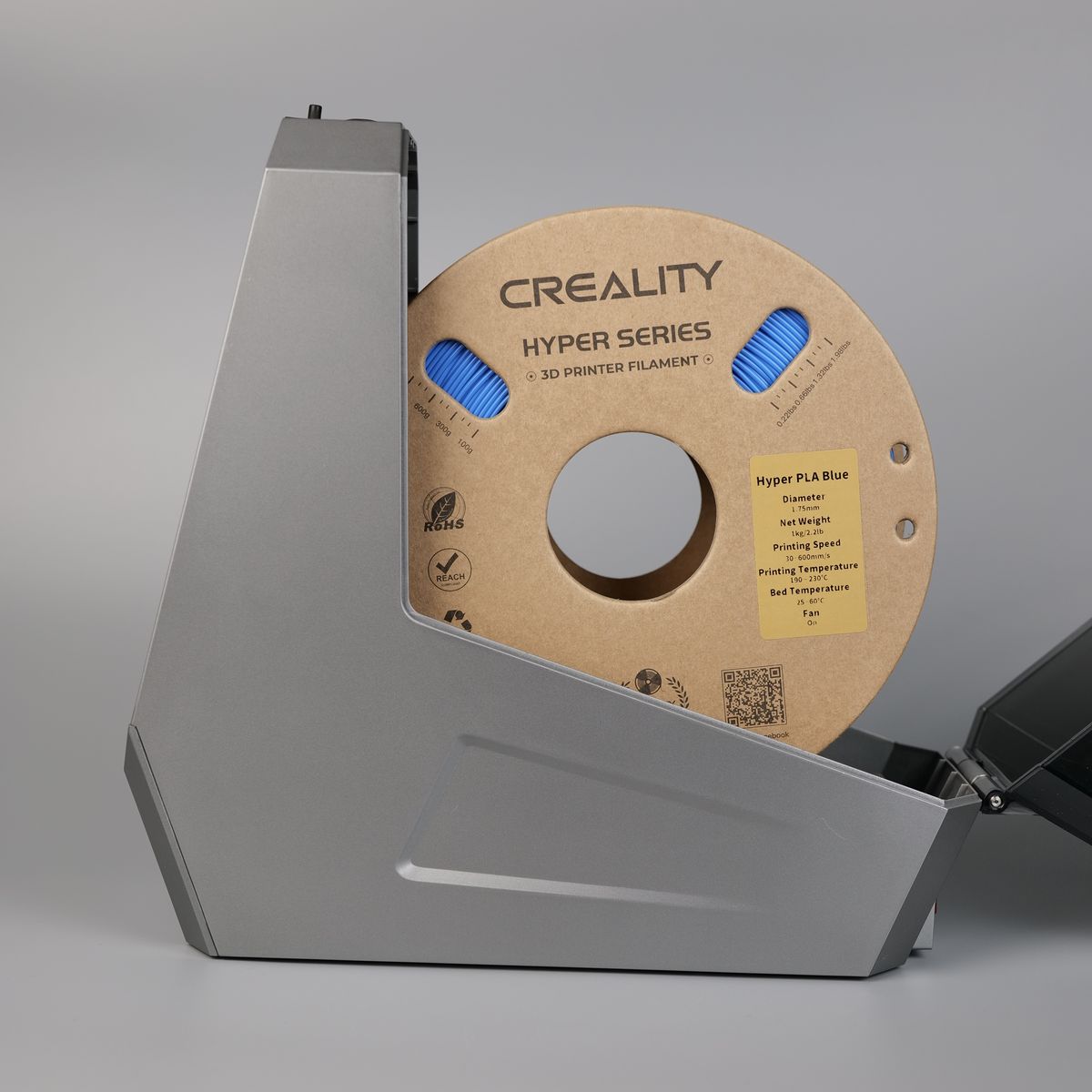
The Creality Space Pi is single-spool filament drier which can be used with only a single 1KG spool of filament, but it also comes with a PTC heater and can reach up to 70C.
I also believe it’s the best looking filament drier from the three compared in this article, but it comes with some drawbacks which I will share later.
| Drying Recommendations | ||
| PLA | 50°C | 4-8h |
| TPU | 55°C | 4-8h |
| PP | 55°C | 4-8h |
| ABS | 65°C | 8-12h |
| ASA | 65°C | 8-12h |
| PETG | 60°C | 4-8h |
| PC | 65°C | 8-12h |
| PA | 65°C | ≥12h |
| РЕТ | 60°C | 4-8h |
| PLA-CF | 50°C | 4-8h |
| PETG-CF | 60°C | 4-8h |
| PA-CF | 65°C | ≥12h |
SUNLU S4
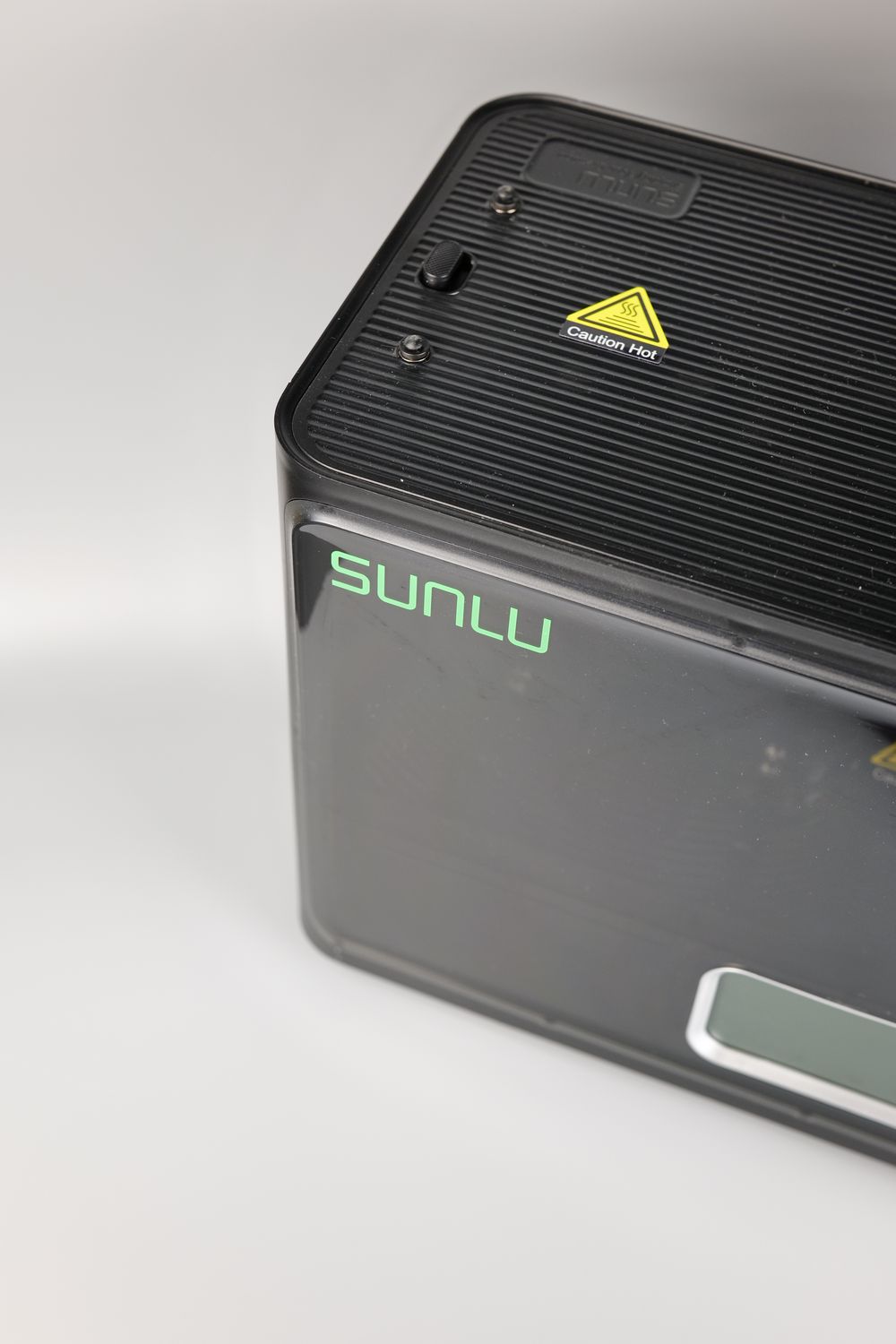
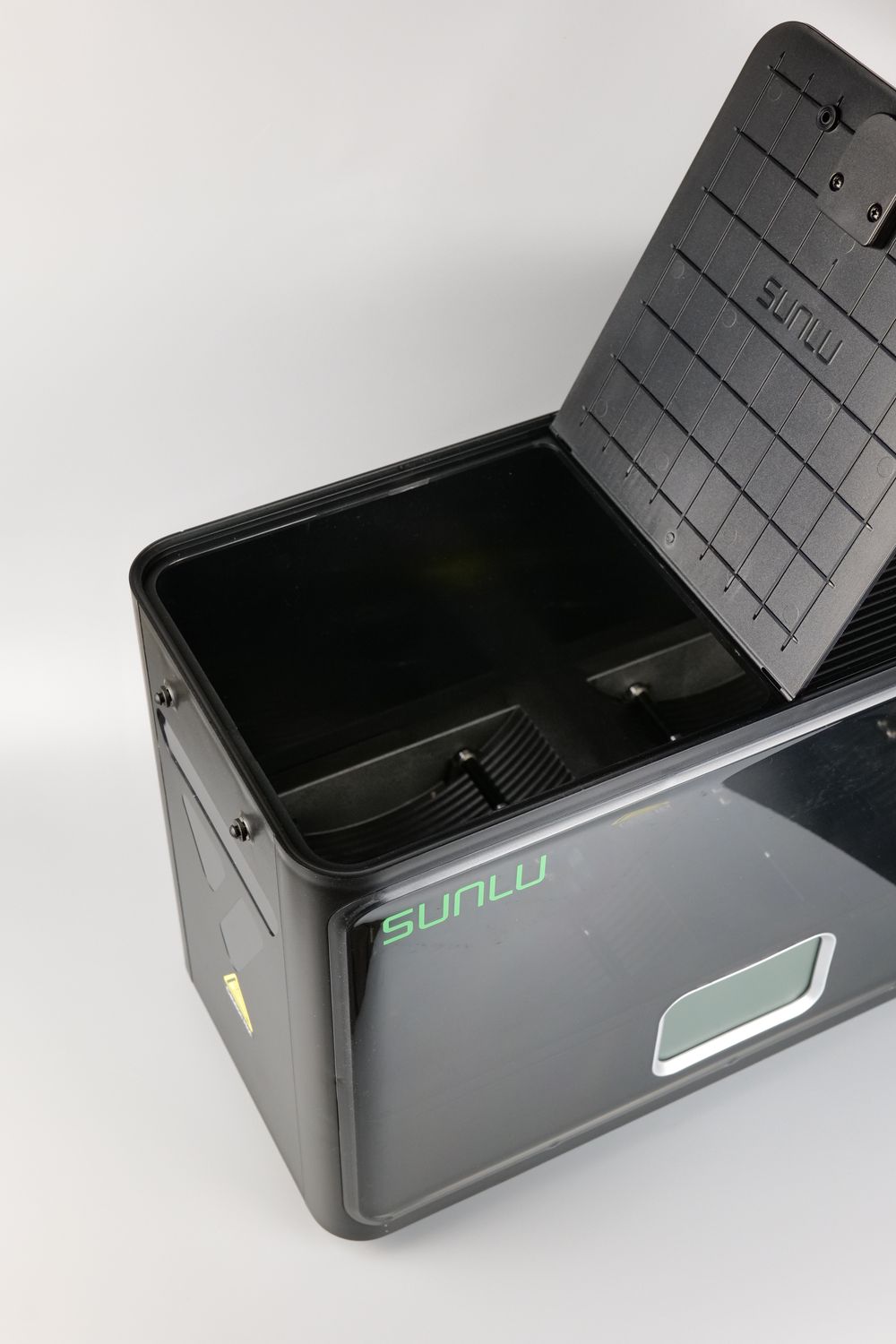
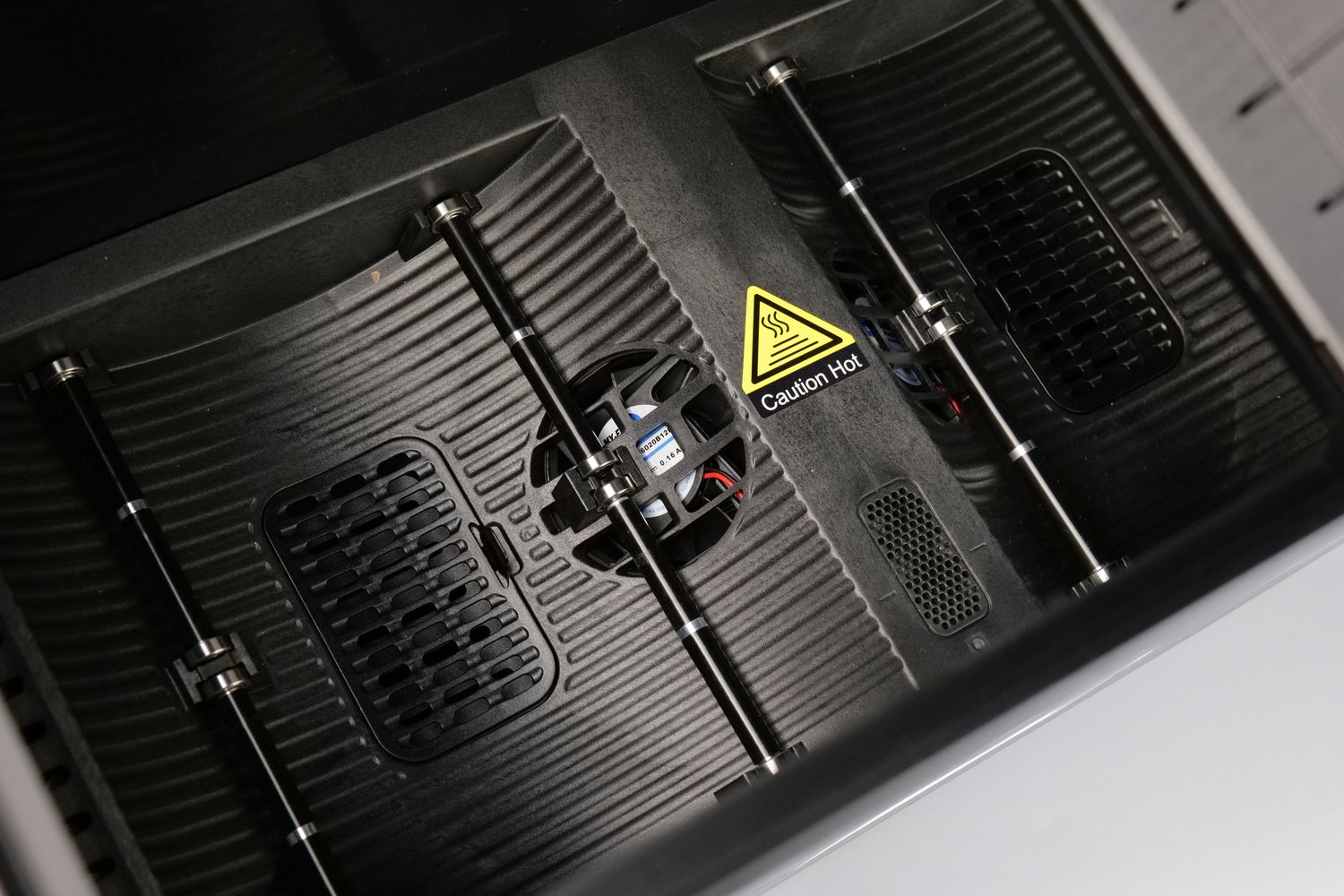
The SUNLU S4 seems like a very good option if you need to dry larger number of spools at the same time. It can dry up to 4x 1KG spools of filament at once which is great for people that use a Bambu Lab AMS system. Talking about that, there’s even a mod that turns the SUNLU S4 into a dedicated AMS lite drier combo which seems pretty cool.
Of course, the SUNLU S4 also comes with a PTC heater with the same drying capabilities of up to 70C.
| Drying Recommendations | |
| PLA | 45-50°C |
| PLA+ | 45-50°C |
| WOOD | 45-50°C |
| PETG | 45-50°c |
| HIPS | 50-55°C |
| ABS | 50-55°C |
| TPU | 50-55°C |
| ASA | 50-55°C |
| PA | 60-70°C |
| PC | 60-70°C |
Temperature Accuracy
To test the temperature accuracy, the filament driers were measured with a temperature probe located in the filament drier, on the top section of the unit at around 5-10mm from the top of the unit.
All driers had filament inside the unit to simulate regular operation.
EIBOS Polyphemus
When it comes to temperature accuracy, the EIBOS Polyphemus is not very accurate at lower tempeartures. It has a measured tempearture difference of +7C, but the unit seems to be more accurate at temperatures higher than 60C.
| Set Temperature | Measured Temperature | Temperature Difference |
| 50C | 57C | +7C |
| 55C | 62C | +7C |
| 60C | 61C | +1C |
| 65C | 66C | +1C |
| 70C | 69C | -1C |
Personally, I was expecthing the temperature to be a bit more consistent to the one reported by the display, but the small inaccuracy could be related to the sensor location in the bottom of the unit.

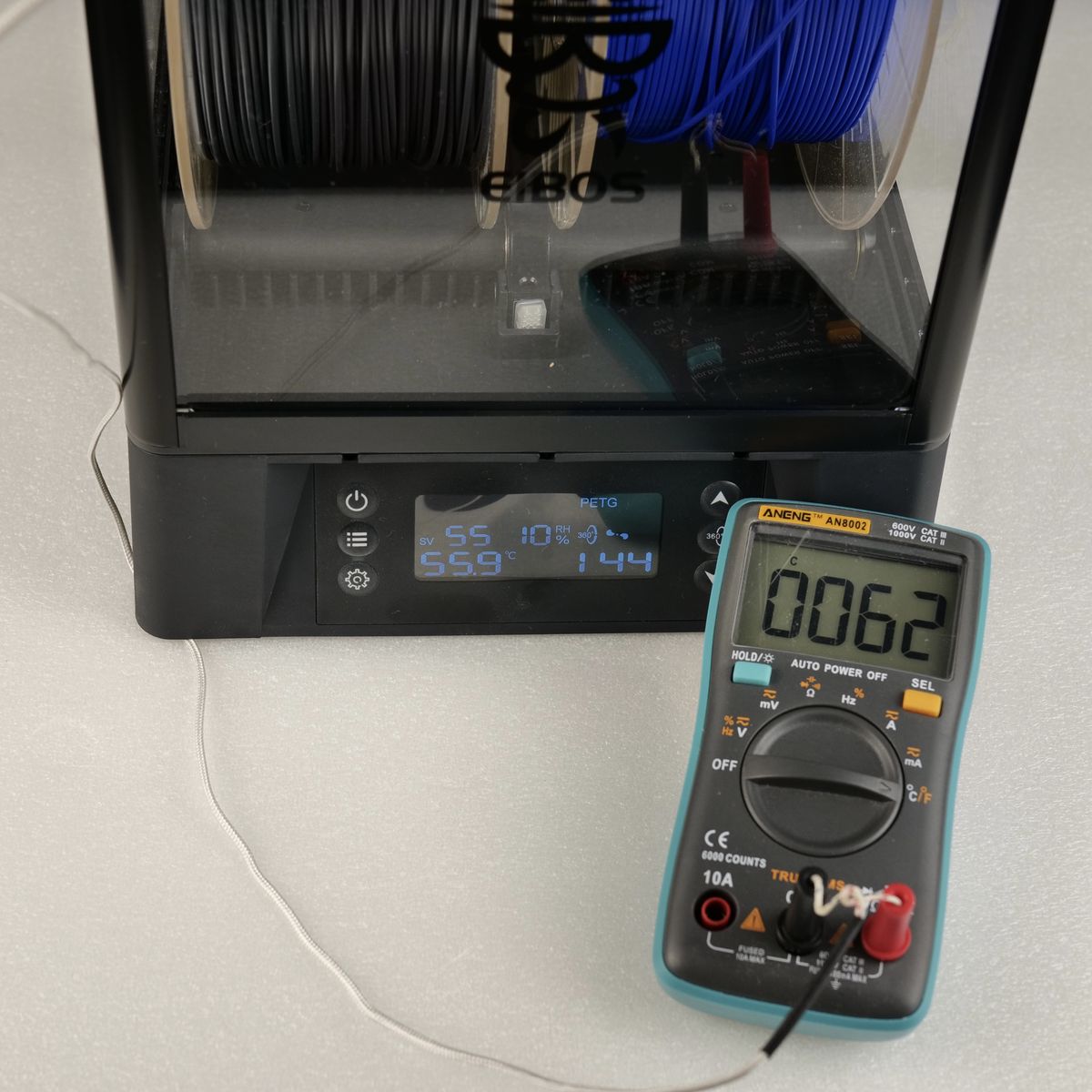
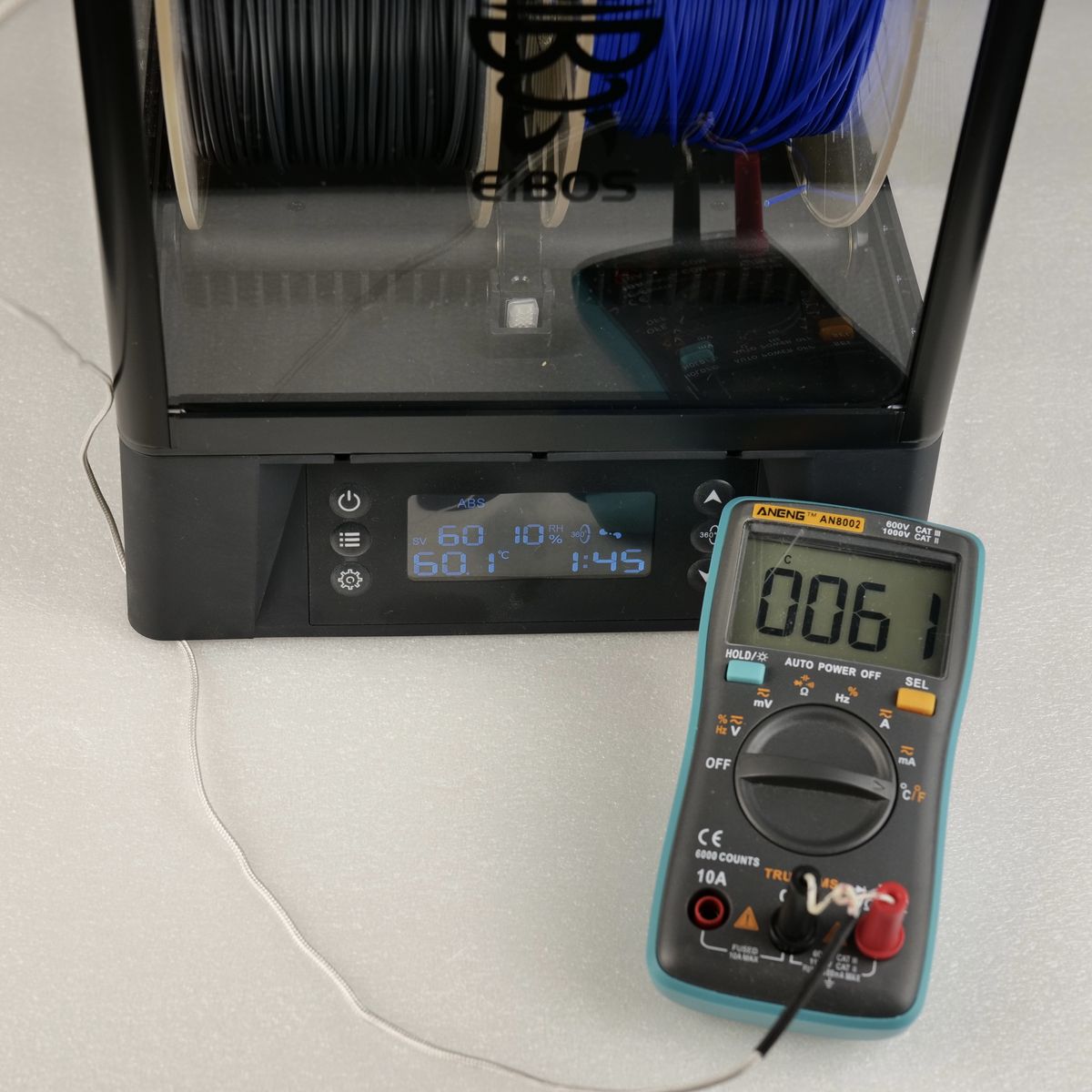
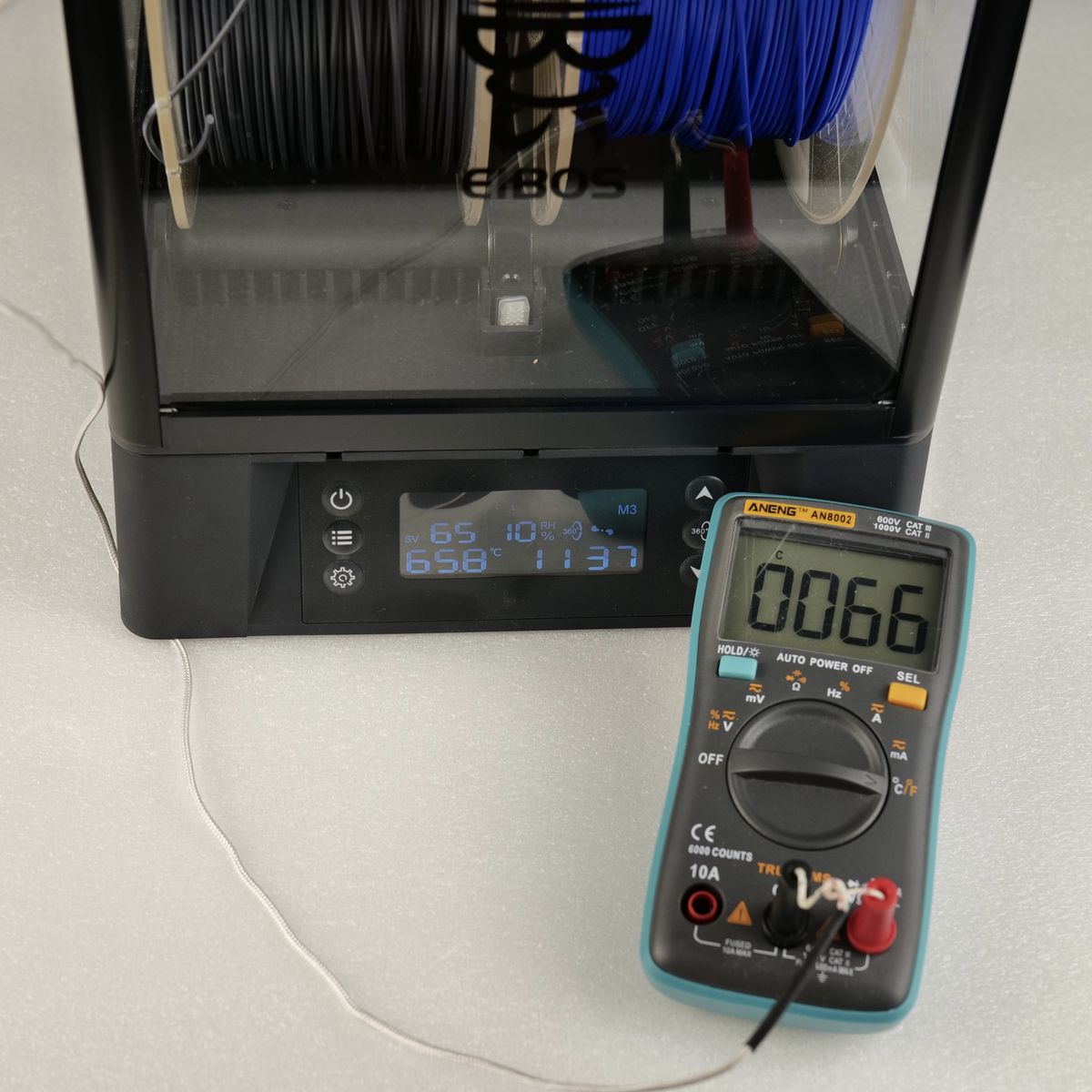
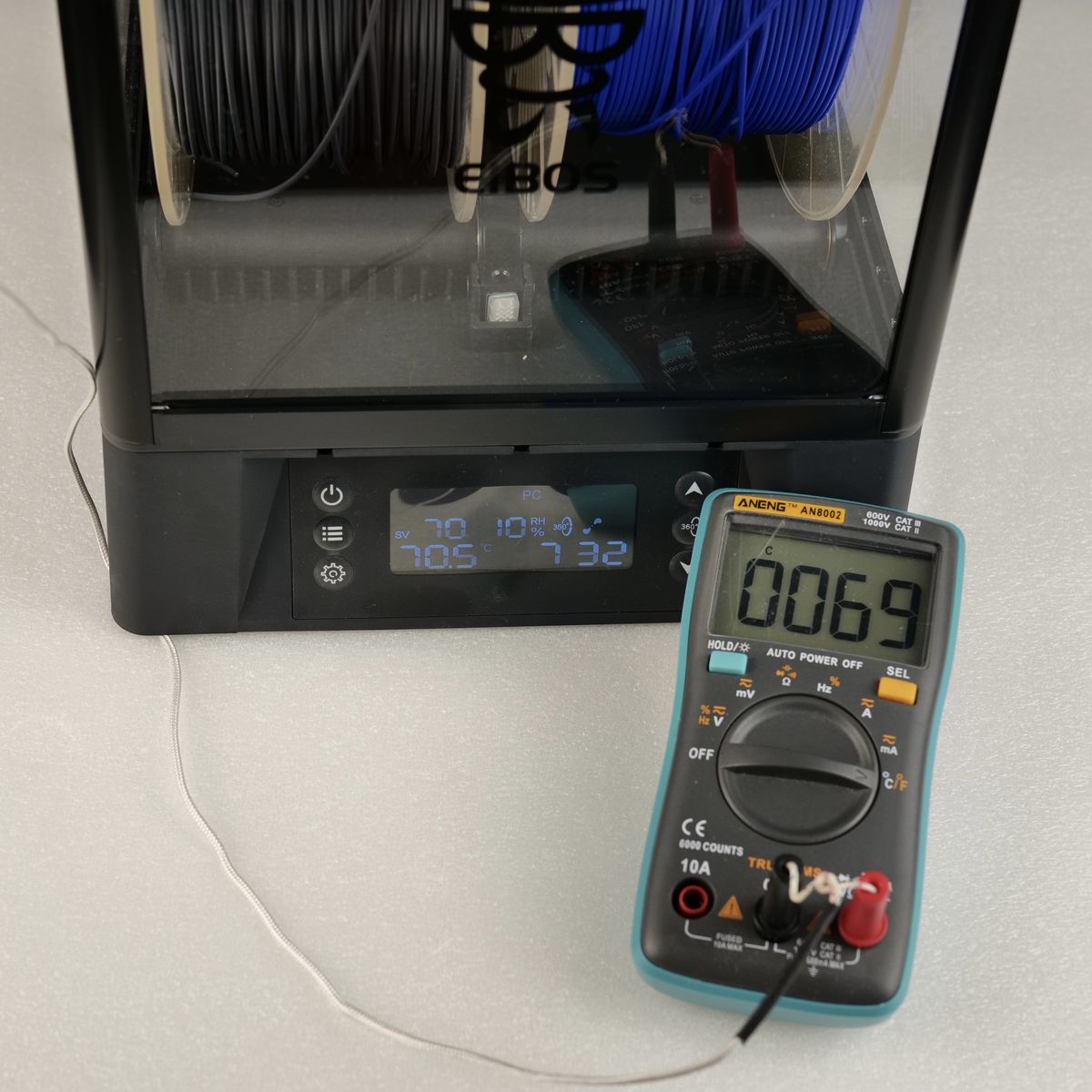
Creality Space Pi
The Creality Space Pi seems to have significant temperature inaccuracies. The smallest temperature difference is +5C while the biggest temperature difference is +14C.
I believe this issue is caused by the less than ideal PID tuning of the heating cycle, and also by the smaller filament drier enclosure which can get hotter faster.
| Set Temperature | Measured Temperature | Temperature Difference |
| 50C | 55C | +5C |
| 55C | 60C | +5C |
| 60C | 71C | +6C |
| 65C | 79C | +14C |
| 70C | 81C | +11C |
Generally, having a small temperature inaccuracy of about 5C should not cause too much trouble, but when the temperature difference goes +10C over the set value, it could lead to damage on the filament.
I recommend considering these inaccuracies when using the Creality Space Pi, especially with lower glass transition temperature like PLA, TPU and even PETG.
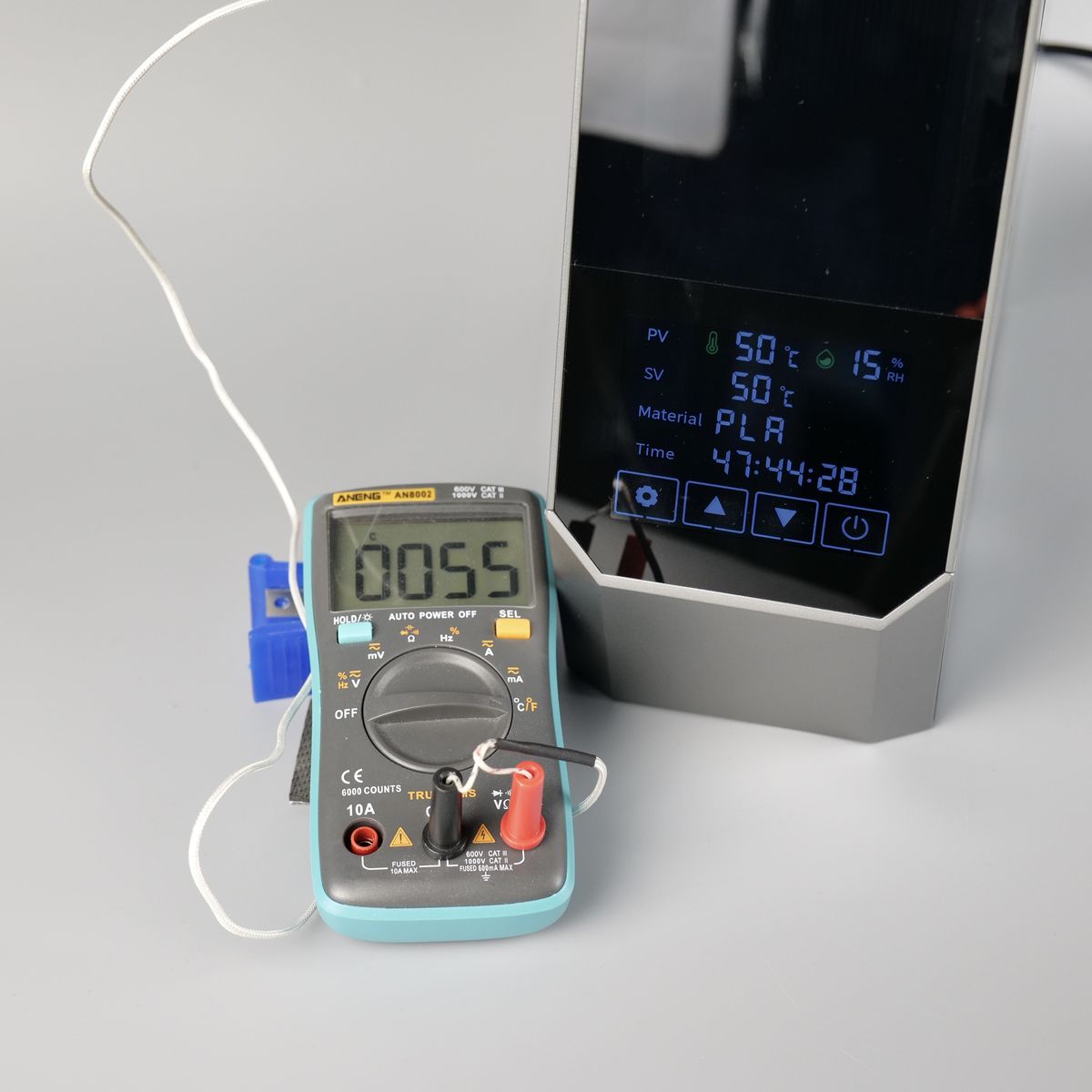
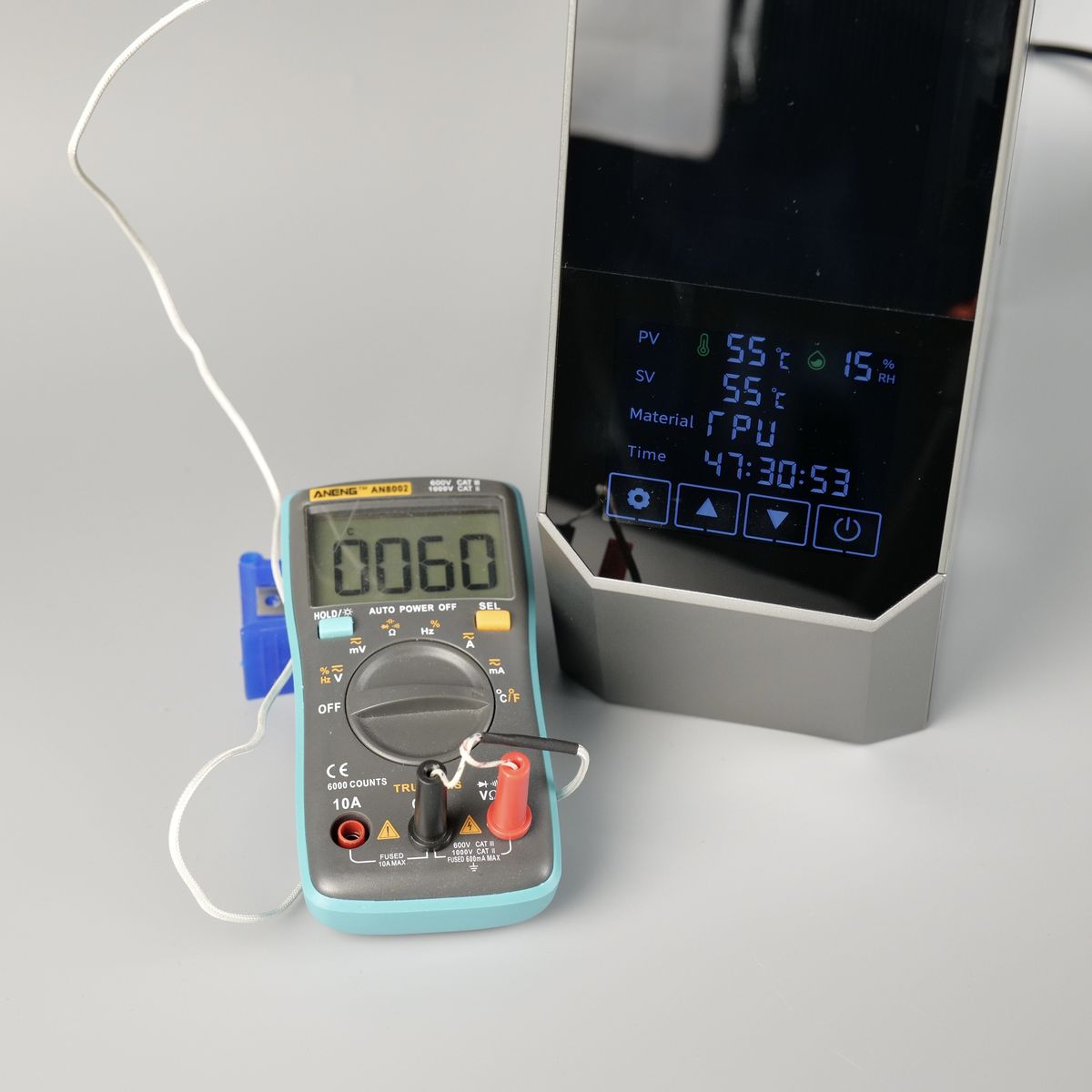
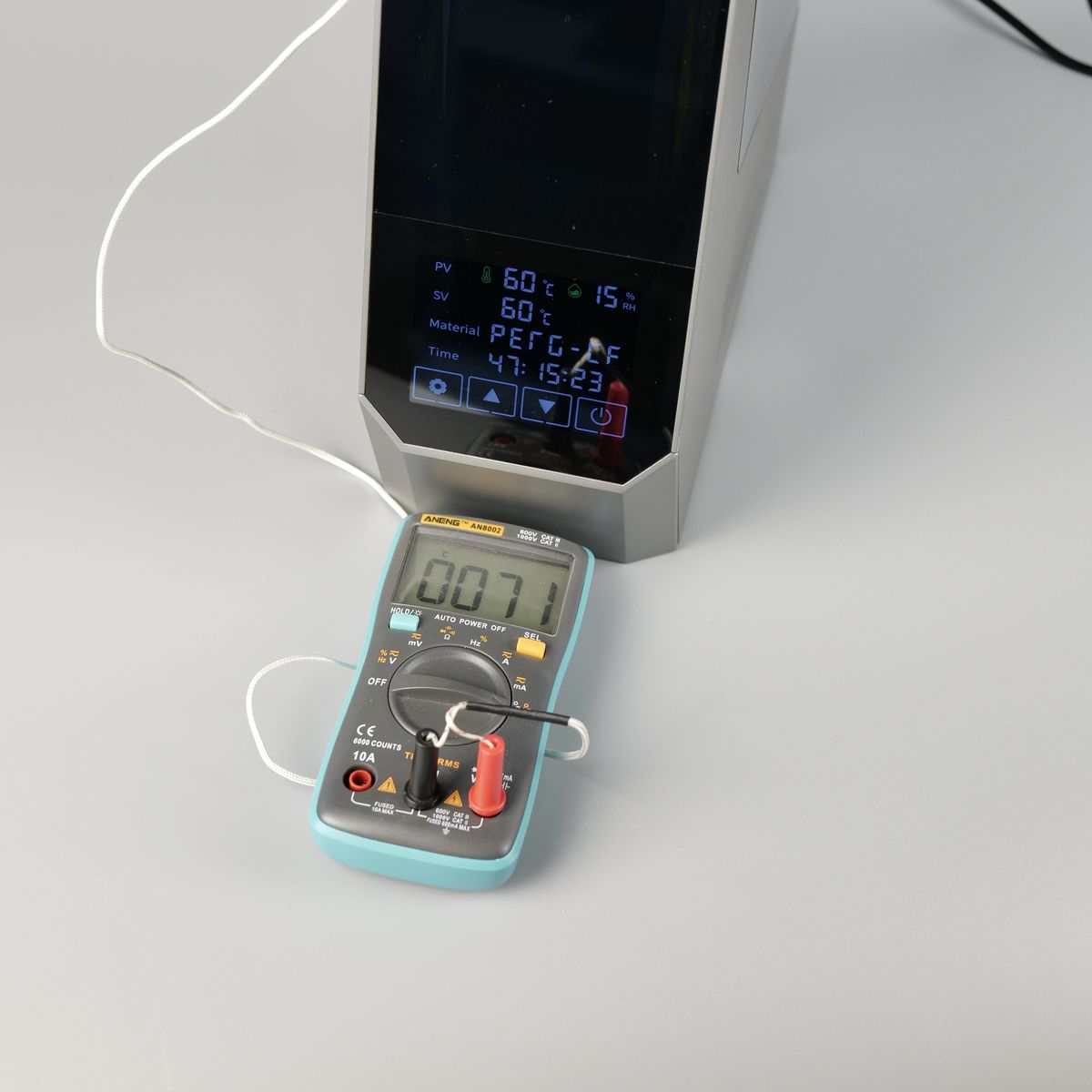
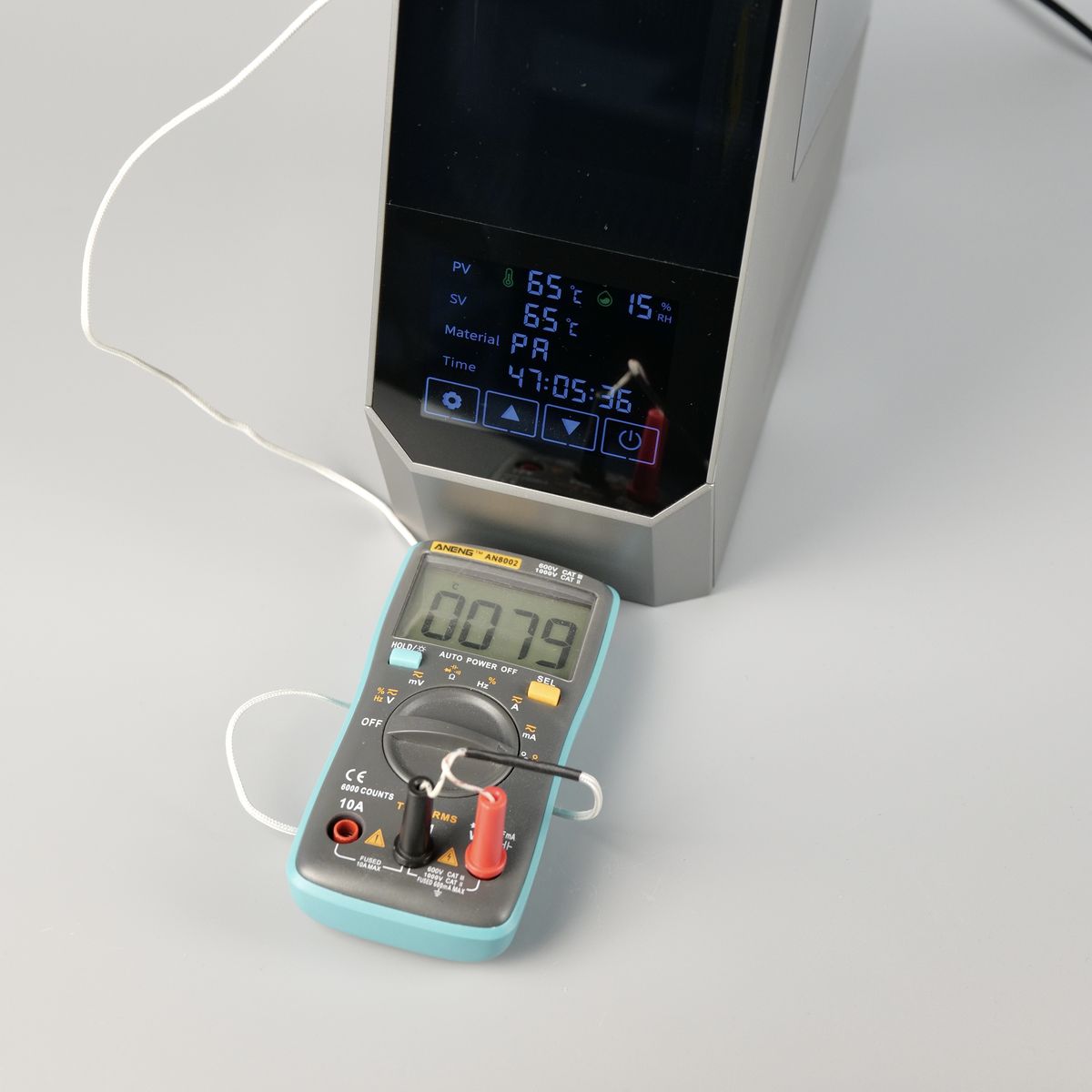
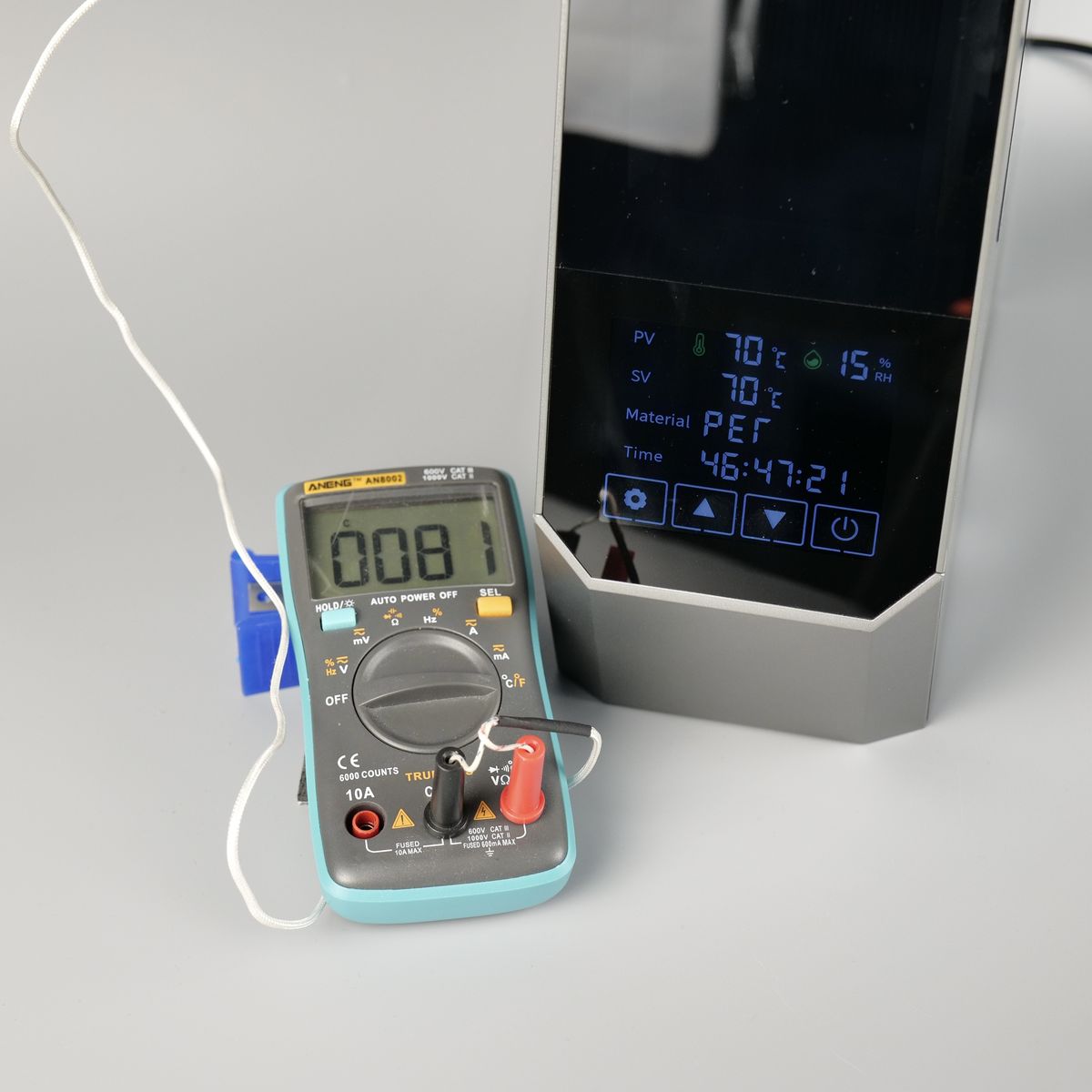
Unfortunately, I did not consider the external insulation of the Creality Space Pi body, which got hot and damaged my photo backdrop due to the heat. I recommend caution on the location where you install this as it does not have good thermal insulation on the bottom of the unit.

SUNLU S4
The SUNLU S4 seems to have a well calibrated PID tuning for the temperature with very slight inaccuracies. Most of the time, the temperature is within the margin of error with -2C to +2C measured.
It’s great to see that all the heating power available for the SUNLU S4 can be accurately tamed and kept stable.
| Set Temperature | Measured Temperature | Temperature Difference |
| 50C | 48C | -2C |
| 55C | 55C | 0C |
| 60C | 59C | -1C |
| 65C | 65C | 0C |
| 70C | 72C | +2C |
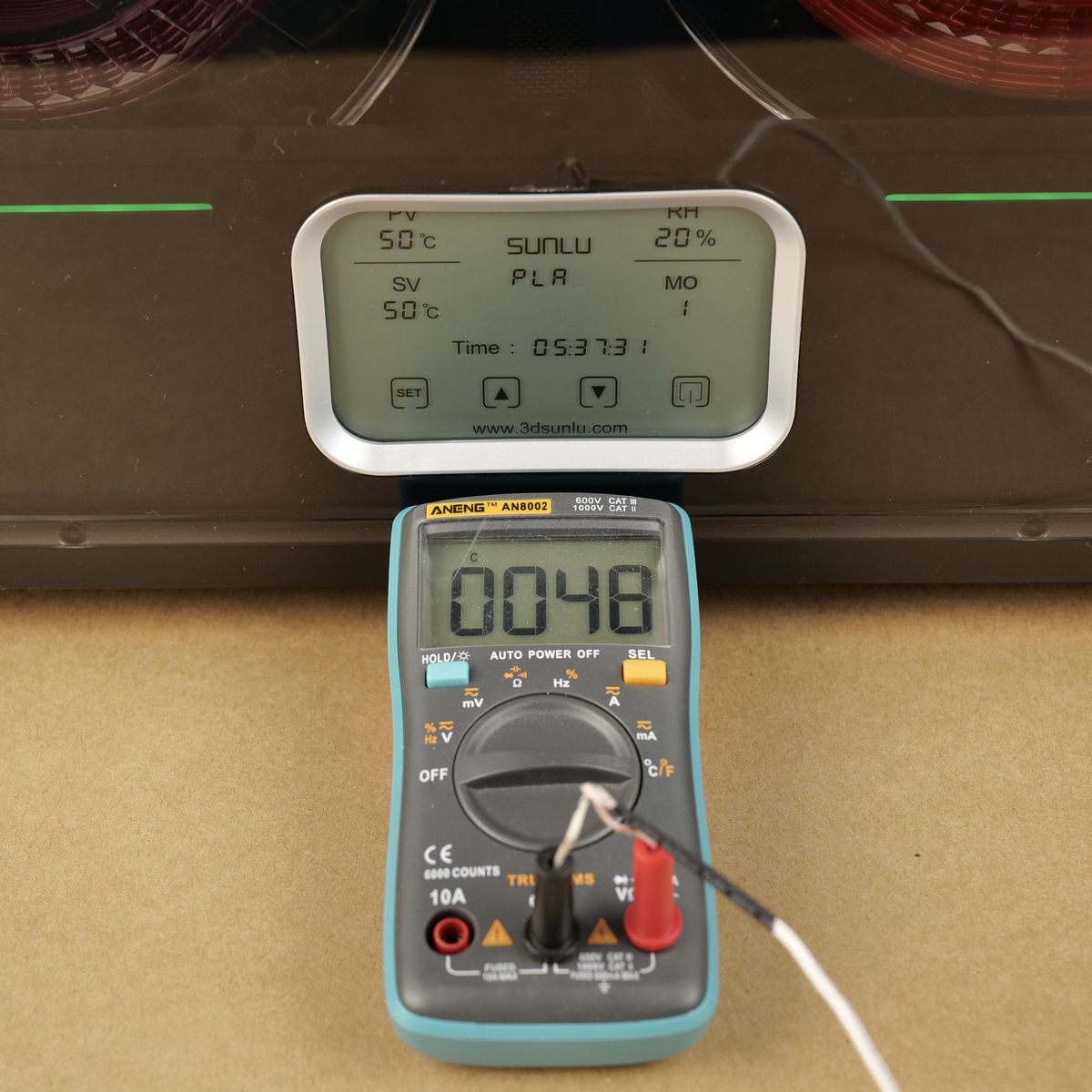
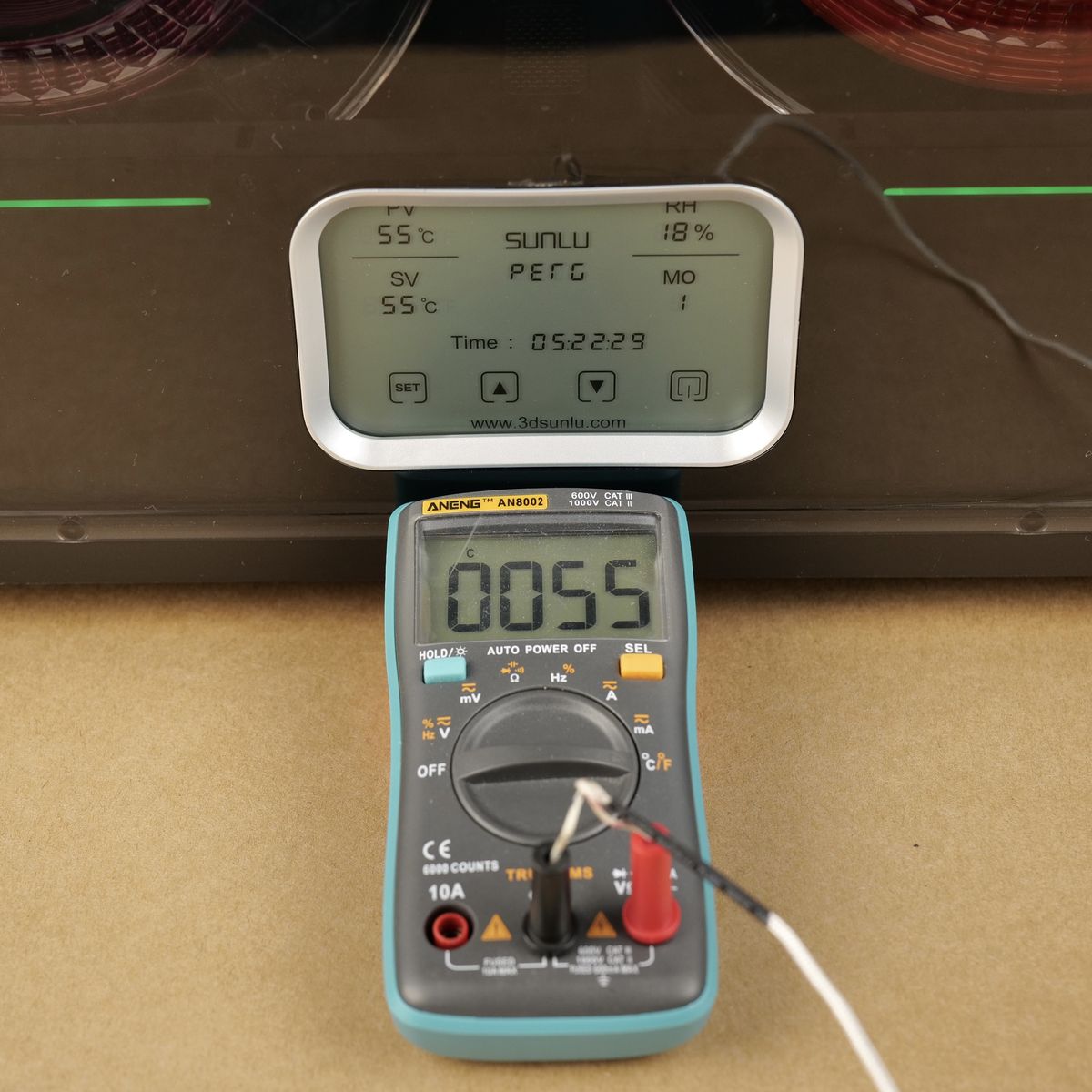
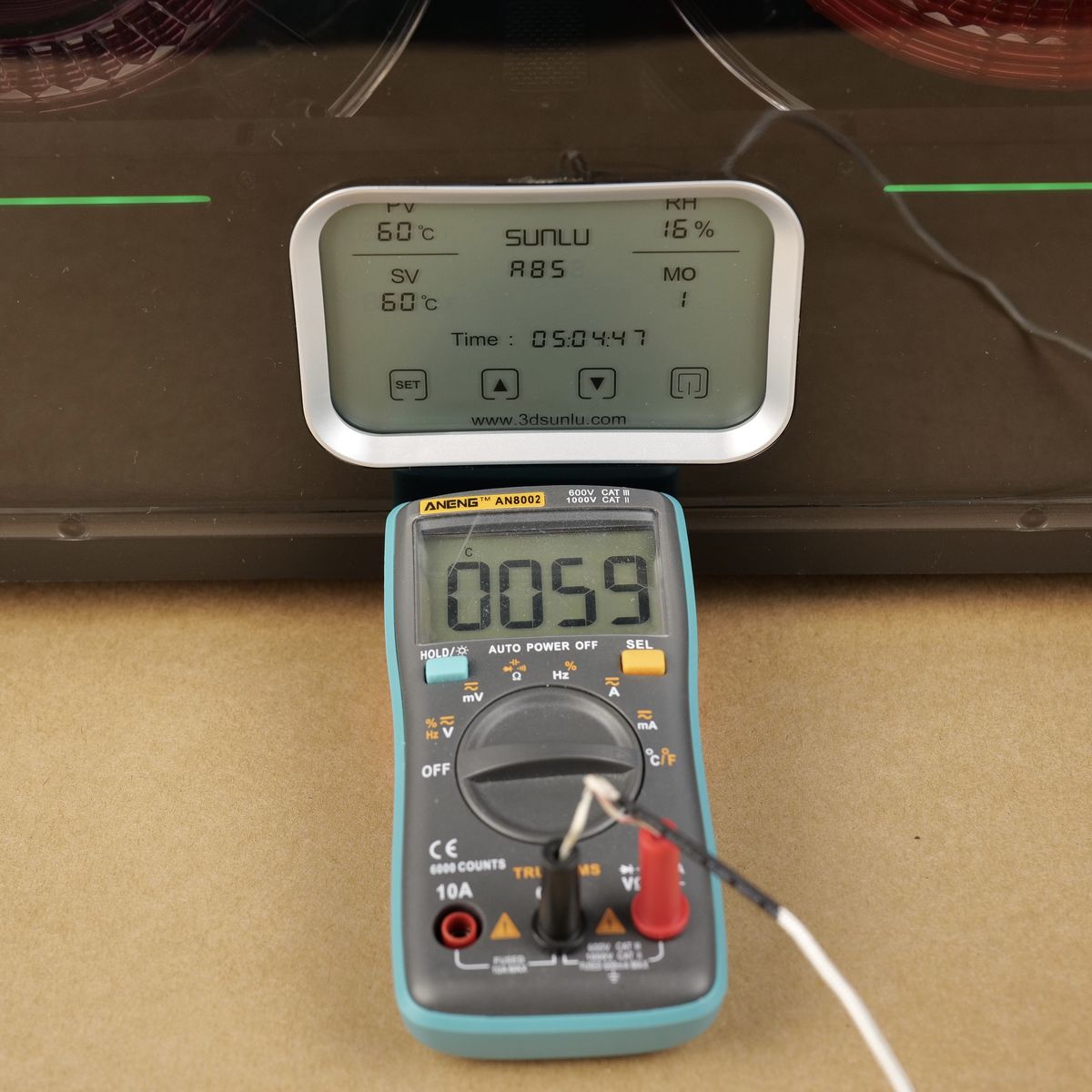
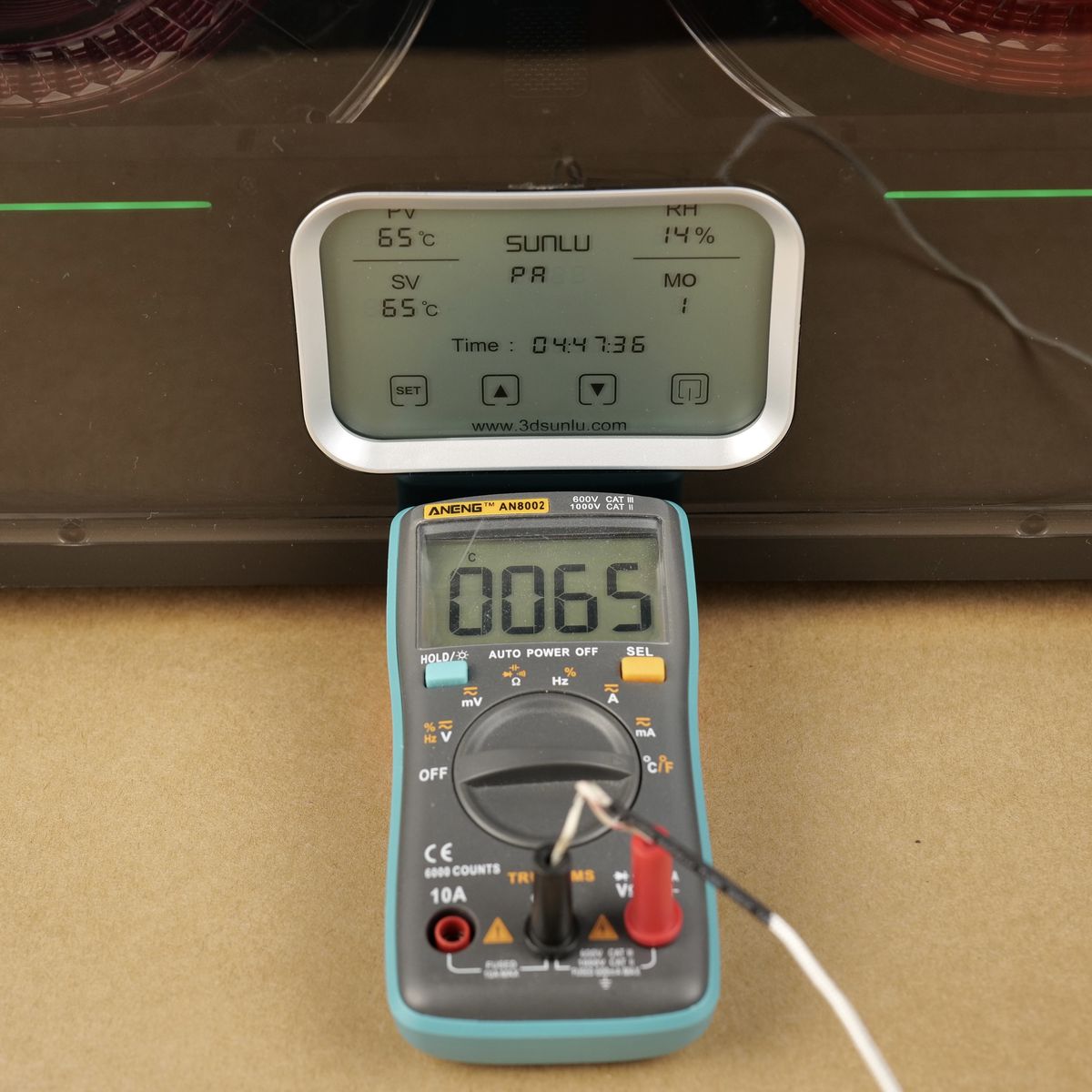
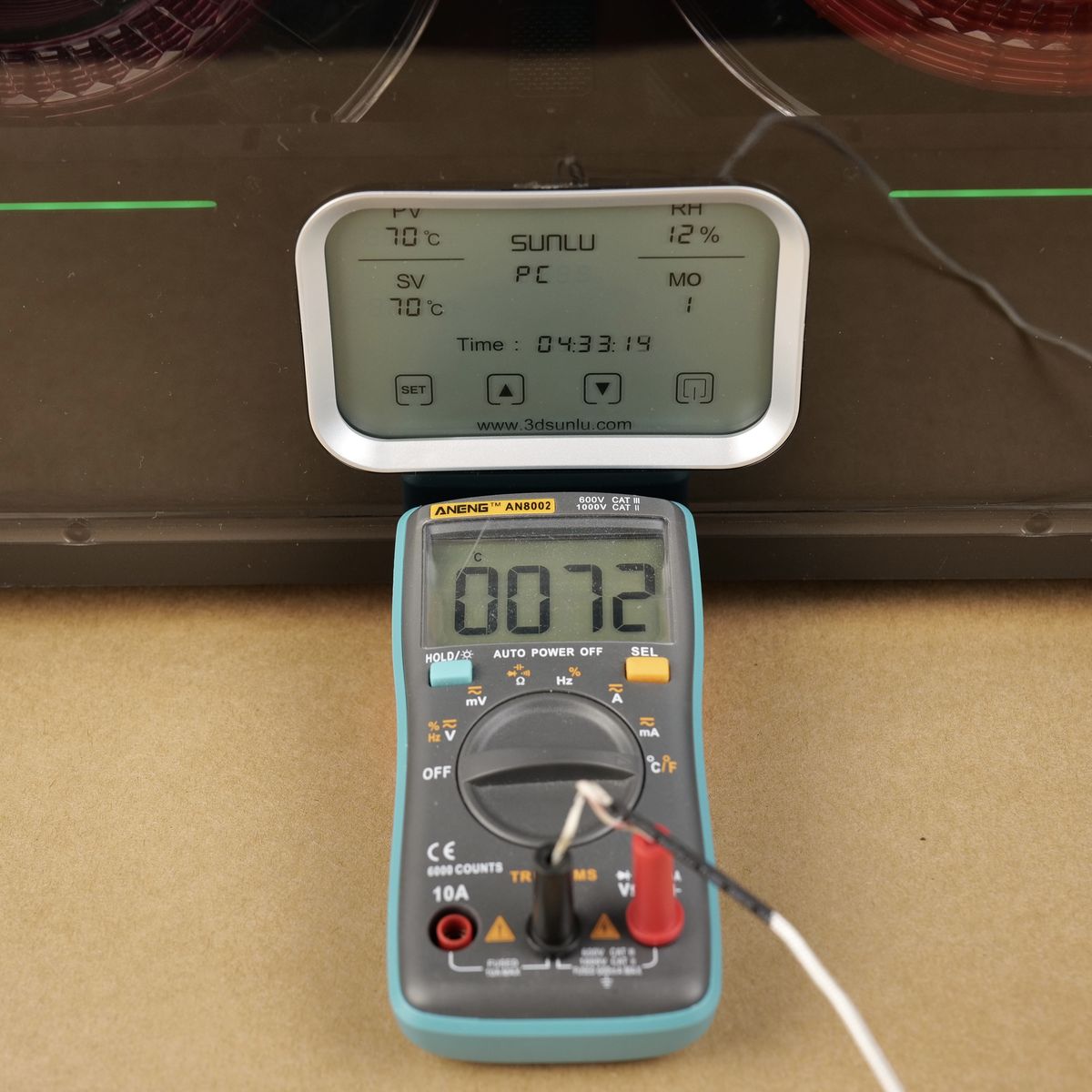
Power Draw
Drying filament is good, but depending on the power requirements of the unit, it can also become expensive in some situations. I have tested all three driers to check what is the maximum power draw you can expect, and the results can be seen below.
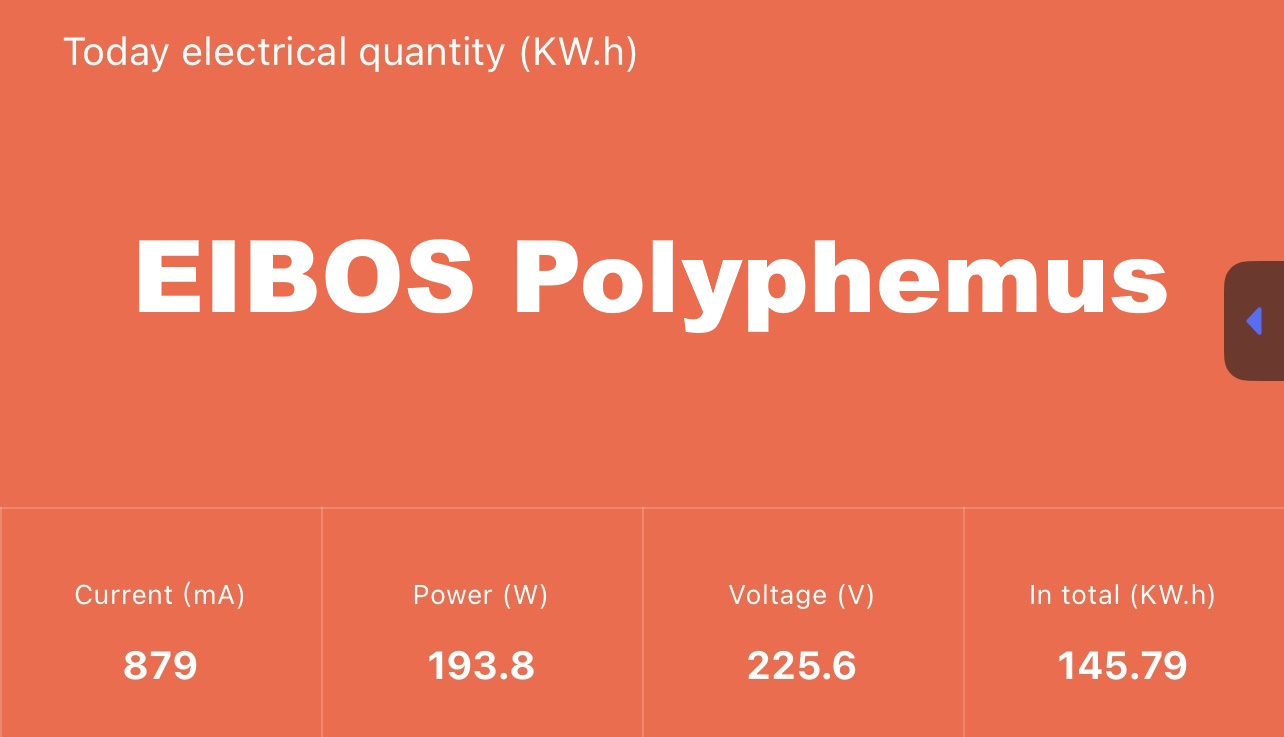
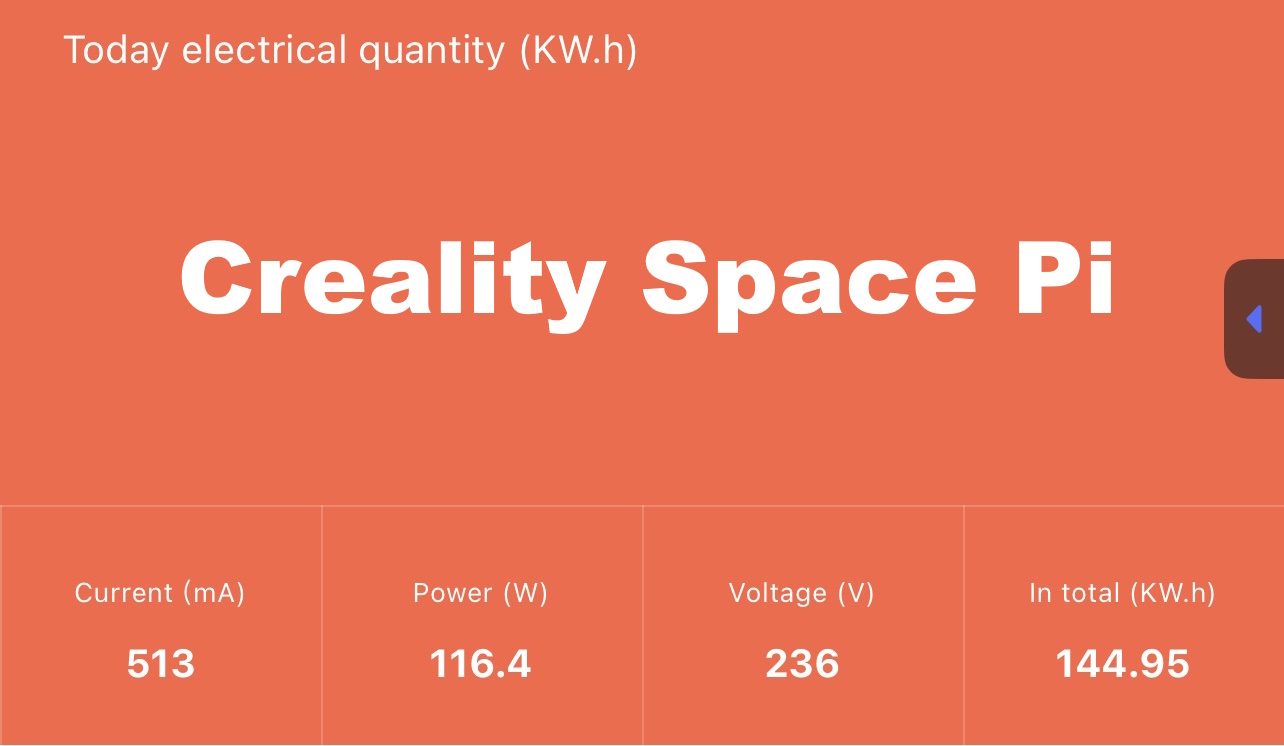
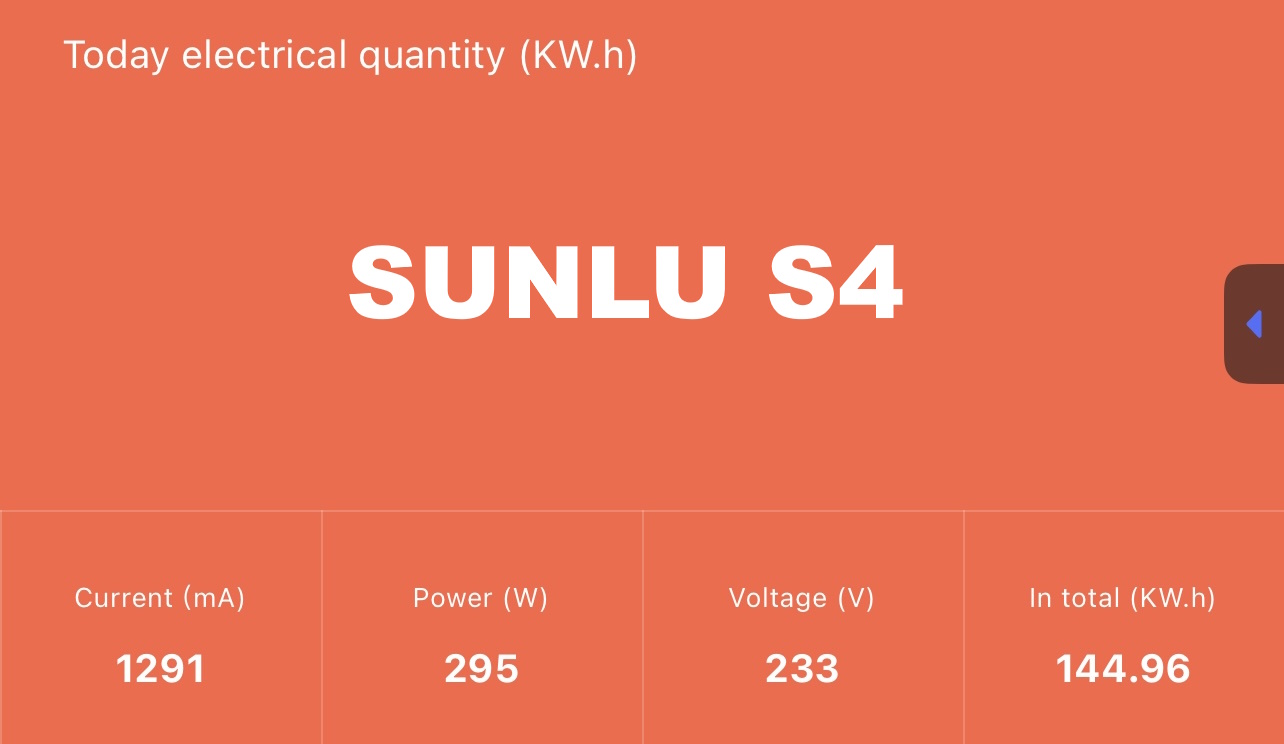
EIBOS Polyphemus can draw up to ~190W which is a bit more than expected, but the draw is not completely stable and varies quite a bit depending on the temperature inside the drier. Considering that you are drying two spools at once, I believe the power draw is acceptable.
Creality Space Pi can draw up to ~120W which seems high considering it’s a single spool drier, but just like in the case of the EIBOS, it goes down after a while depending on the temperature inside the unit.
SUNLU S4 can draw up to ~295W which is the most power hungry drier in this test. Still, it is also one of the more “economical” ways of drying the filament as you can dry up to 4 spools at once which can be a plus for most.
The Good, The Bad and The Ugly
EIBOS Polyphemus
When I received the EIBOS Polyphemus, I wasn’t so happy to see that I needed to assemble it before use. It takes about 15 minutes to put together, but compared to the other driers tested, it’s the only one that required assembly.
Drying performance is good, and I like the adjustable opening on the top of the unit to let the moisture out. It’s such a simple addition to the unit and I hope other manufacturers do the same in the future.
Unfortunately, the Polyphemus cannot be used as a dry box. This is due to the lack of any rubber gasket installed on either the top cover or the bottom section of the drier.
Not having good insulation means that the drier is only effective as long as it is turned on. If you turn it off, the moisture will start to creep back in. And using the integrated silica drying slots would not be effective.
The Polyphemus is also the only drier which has the spool turning feature during drying, but the motor used seems a bit weak. It can turn 2x 1KG spools of filament, but I noticed that in some cases the spools stop turning. It might be a problem with the motor, so it’s a good thing that EIBOS included a spare in the package.
The button controls instead of a touchscreen option are a plus for me, and I like this more than the other driers as it makes the process of selecting a temperature or configuration easier (at least for me).
When it comes to noise levels, the Polyphemus is probably the most silent from the three I tested. The fan is quiet and the spool turning motor generates just a bit of noise.
Overall, the EIBOS Polyphemus is a respectable PTC filament drier, but considering the price it’s sold at, I was expecting a bit more. Especially for the spool turning feature which doesn’t seem too strong,
Creality Space Pi
The Creality Space Pi has as main drawbacks the single-spool configuration and the larger than expected temperature inaccuracy.
Drying performance is good for a single spool, with the drier reaching a high temperature fast. But the inaccuracies I have measured make me a bit scared for using it with PLA as it might get a bit too hot and cause problems to the filament. Still, for other higher temperature filaments the unit should work quite well.
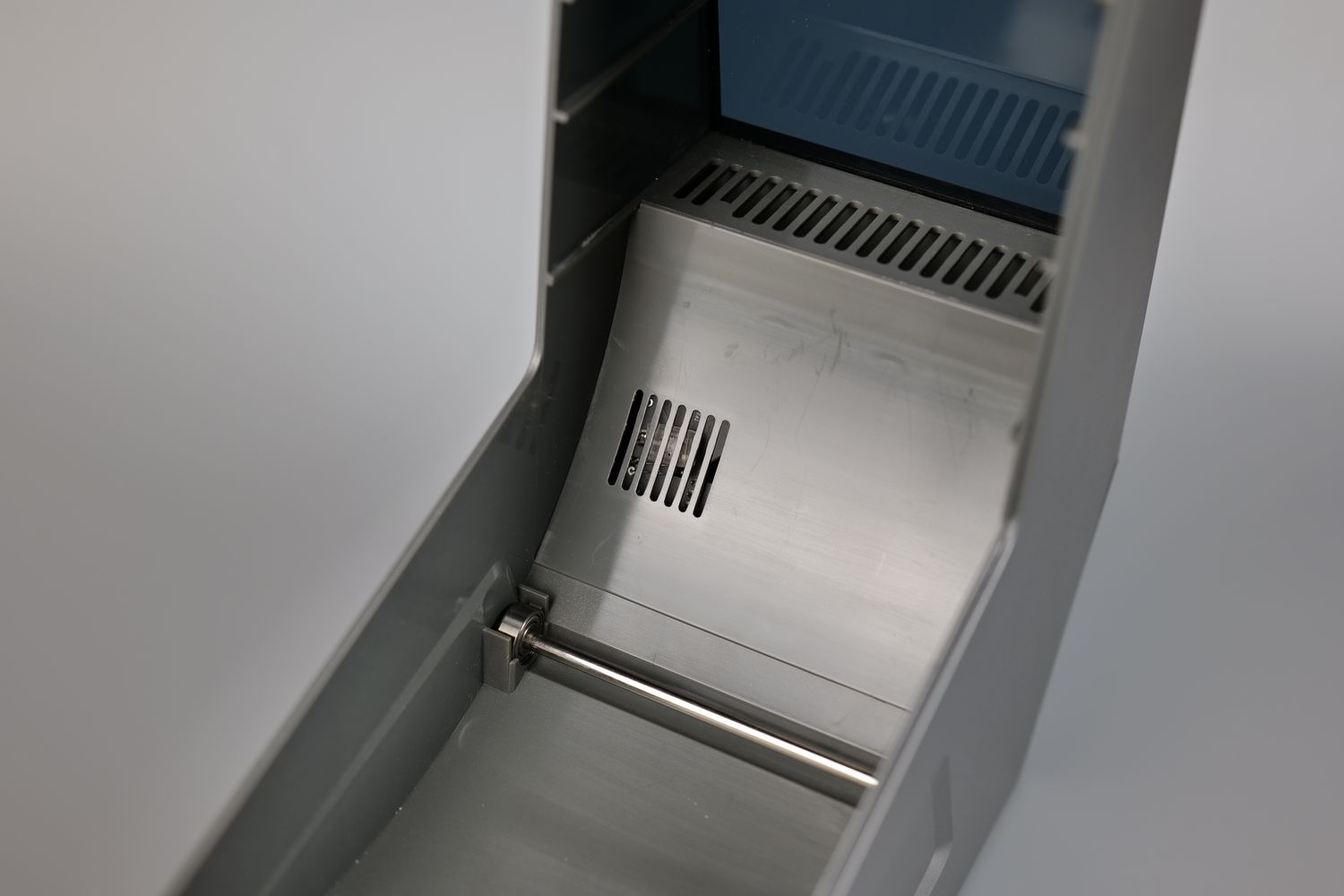
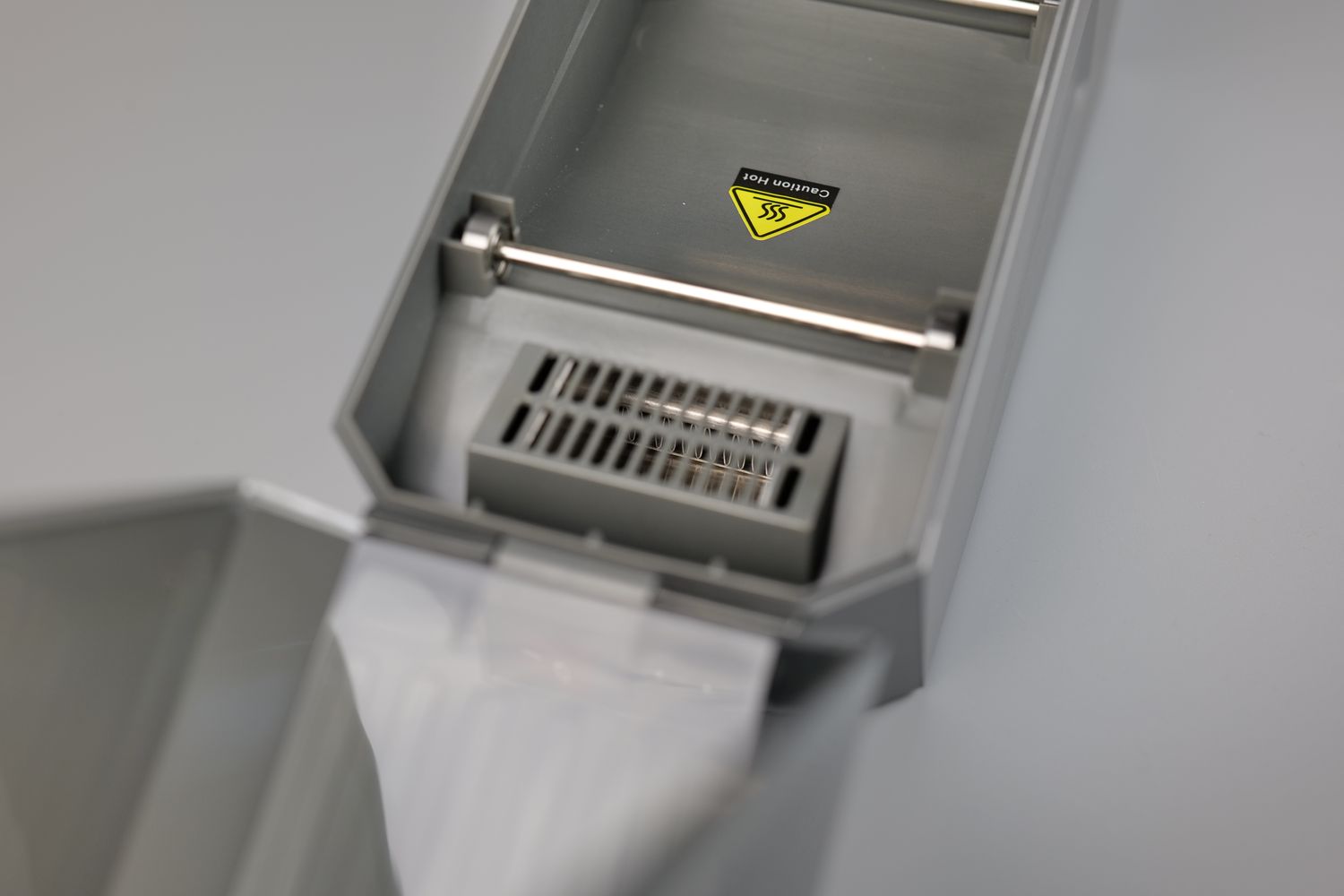
What I don’t really like is the fan noise levels generated by this drier. Unfortunately, Creality always seems to use loud fans and for such a small unit I don’t think you need so much RPM for the fans.
It’s a bit annoying to use when no printer is running, but if you’re printing with a machine like the Creality K1C while using Space Pi, I don’t think you would notice it.
Just like the other driers, the Space Pi cannot be used as a dry box due to the lack of better insulation. Besides that, there’s a very small hole in the unit which I guess it’s made for better drying performance to eliminate moisture.
Unfortunately, I think the hole is too small to be useful, and an annoyance if you try to keep the filament away from moisture.
The touchscreen interface looks nice and futuristic, but I don’t like it. Most of the time, it is hard to turn the unit on, or to change different values/settings on the screen. For some reason, this issue occurs randomly and solves itself. But it’s still a bit frustrating compared to the other driers.
Space Pi is a decent filament drier for a single spool, but if I were to purchase one, I would get a dual-spool version instead of this one as I regularly print with more filament.
SUNLU S4
The SUNLU S4 is already quite popular, and after testing it for a longer period, I now understand why there’s so much hype around it as there’s a lot to like.
Having the possibility to dry up to 4 spools of filament at once is great especially if you are a Bambu Lab AMS user. You can easily dry a set of 4 spools then move those spools in the AMS to keep them insulated from the environment which is great.
Unfortunately, the S4 suffers from the same issues as the other driers which is the lack of good sealing which doesn’t allow the unit to act as a dry box. If you leave the filament overnight in the filament drier, the next morning the humidity inside is the same as the environment which is not that great.
And that’s a shame as the S4 could a much better drier / dry box combo if proper insulation would have been installed, as the drying performance is excellent. The S4 seems a bit better insulated, so maybe placing silica gel beads in the unit and replacing them often could help, but it’s still not good enough to ensure moisture is not getting in.
Temperatures are accurate and drying is fast, although the noise level of the two fans running in the unit are a bit noisier than I would like. The touchscreen interface is also working relatively fine, but I would rather have regular buttons instead of the capacitive interface.
At the moment, the S4 is the unit I run the most because I can dry a larger batch of filaments in one go, leaving it running over night to avoid the additional noise during use. I don’t like the shiny plastic design, but I love the drying performance.
Conclusions: Which is the best PTC Filament Drier?
After testing all three filament driers, the Creality Space Pi, EIBOS Polyphemus and SUNLU S4, I personally like the SUNLU S4 the most due to the temperature accuracy and the large capacity for filament drying at once. It’s fast and accurate, while being a bit loud and a fingerprint magnet.
The price is also quite attractive considering that you get a 4-spool drying capability and good performance.
The second favorite is the Creality Space Pi due to its really nice design and good drying performance, even though it’s not that accurate on certain temperatures. While I didn’t test it yet, I would recommend getting the Creality Space Pi Plus as it is larger and just slightly more expensive.
Finally, there’s the EIBOS Polyphemus. I believe it’s worthy of second place next to the Space Pi, because the drying performance is good, and it brings new features like the spool rotation motor.
The main thing I don’t like is the price, which is a bit too high for what this unit offers and having to assemble the unit is not that great. The SUNLU is very closely priced and makes it a more attractive option for me. But if you need a 3KG spool drier, this is the only solution at this time, so maybe it’s just what you’re looking for.
I really hope that future generations of filament driers will also be designed to be used as a dry box. None of the filament driers I tested include enough insulation or rubber seals to ensure the filament stays moisture free after it has been dried, which is a shame.
As usual, I recommend checking other reviews and opinions for the items I have reviewed before making a purchase decision.
Where to buy?
You can purchase the Creality Space Pi, EIBOS Polyphemus and SUNLU S4 from the following stores:
Creality Space Pi
Creality Store
Amazon
EIBOS Polyphemus
EIBOS Store
SUNLU S4
SUNLU Store
Amazon
The Creality Space Pi was provided free of charge by Creality for the purpose of this review.
The EIBOS Polyphemus was provided free of charge by EIBOS for the purpose of this review.
The SUNLU S4 was provided free of charge by SUNLU for the purpose of this review.
While the article includes affiliate links, all opinions are my own. Nobody reviewed the article before it was posted, following the Review Guidelines.
Liked it?
|
|

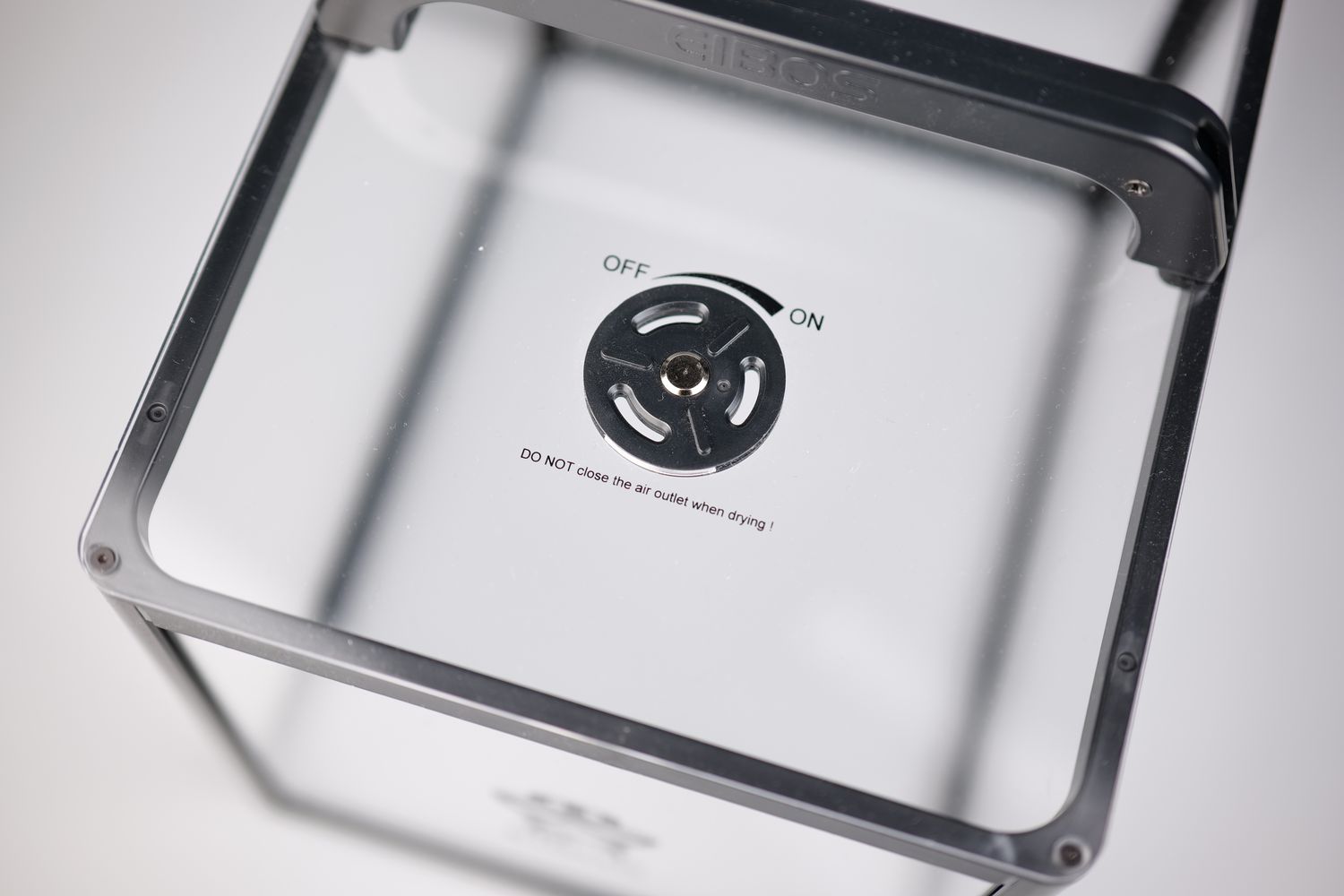
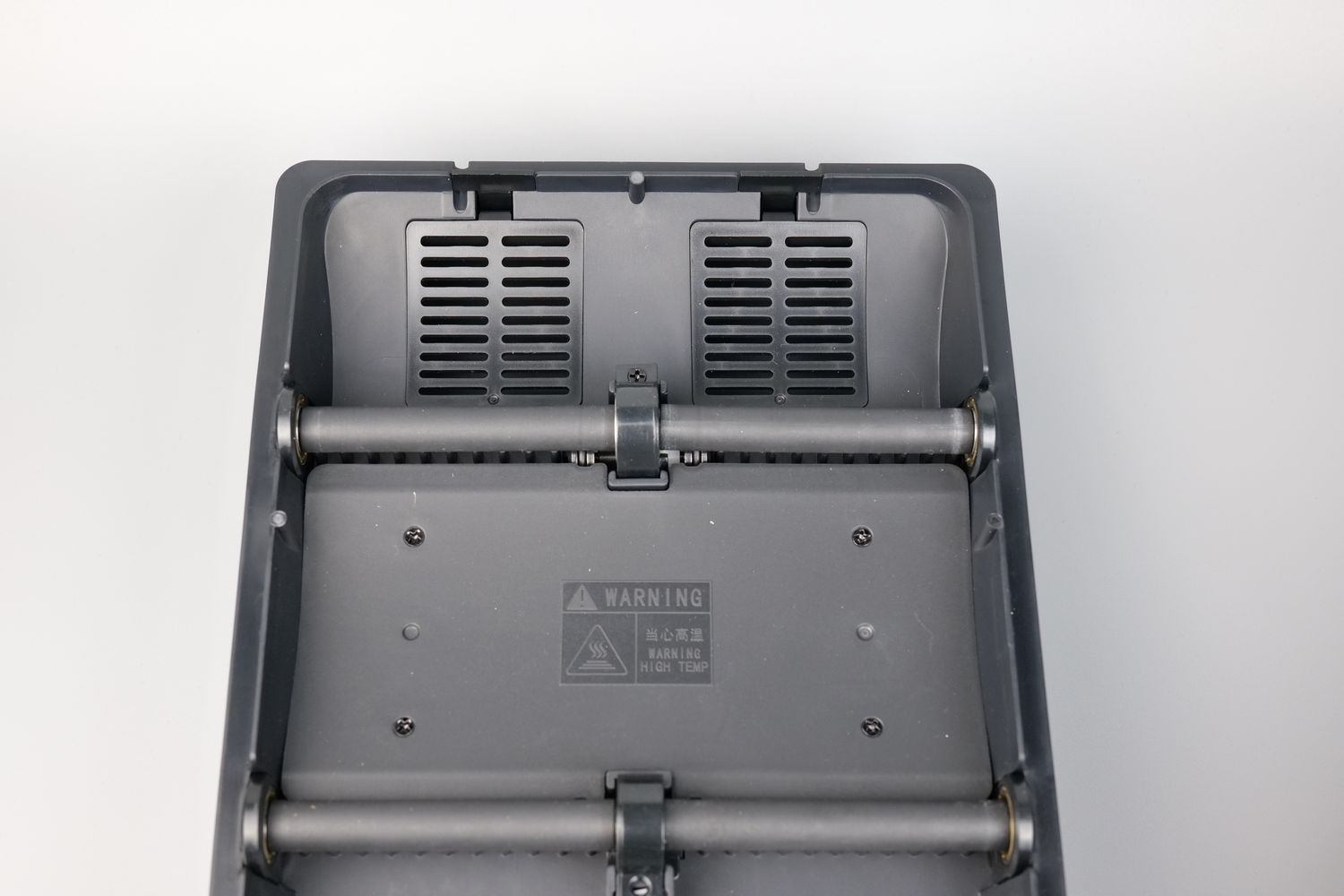

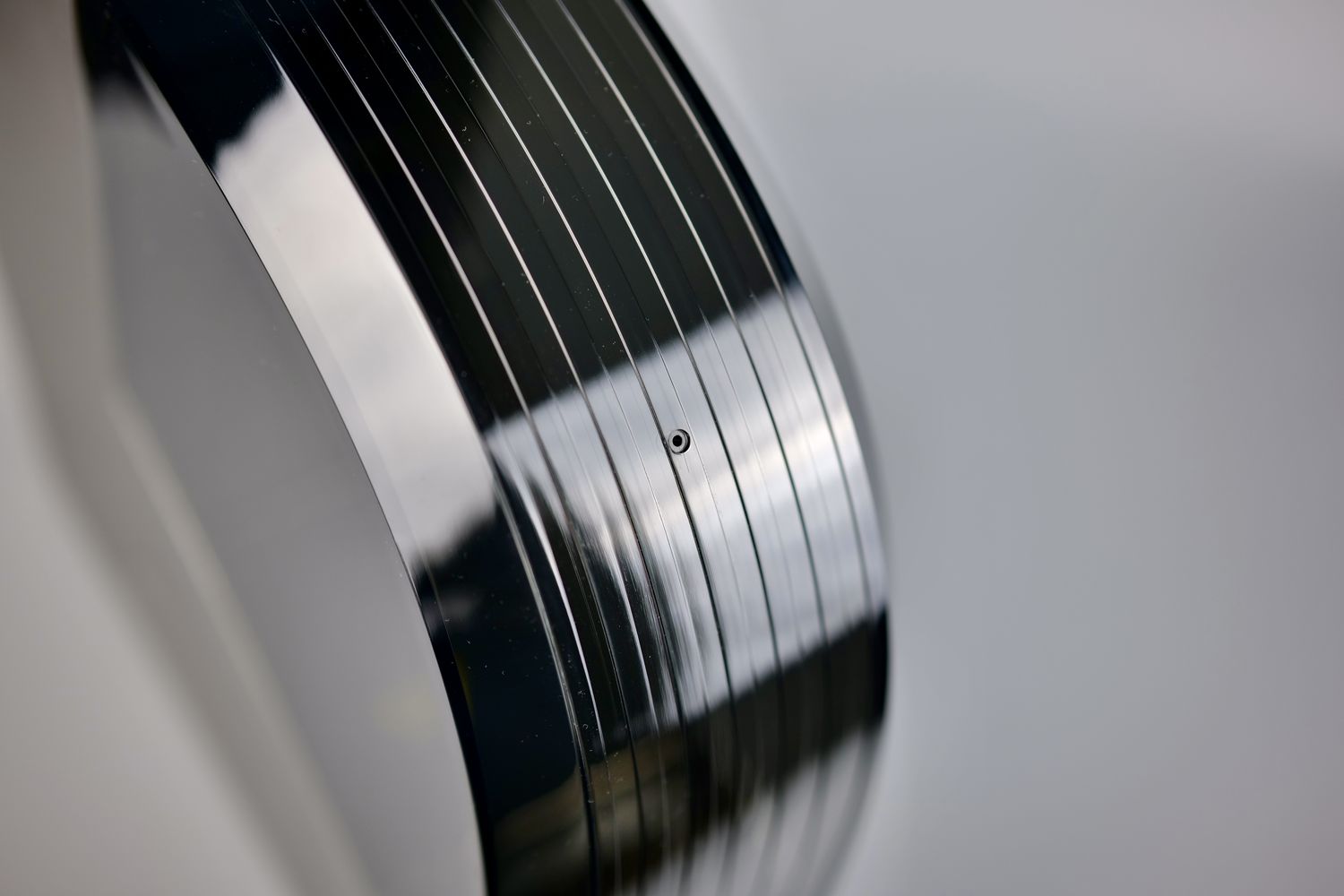
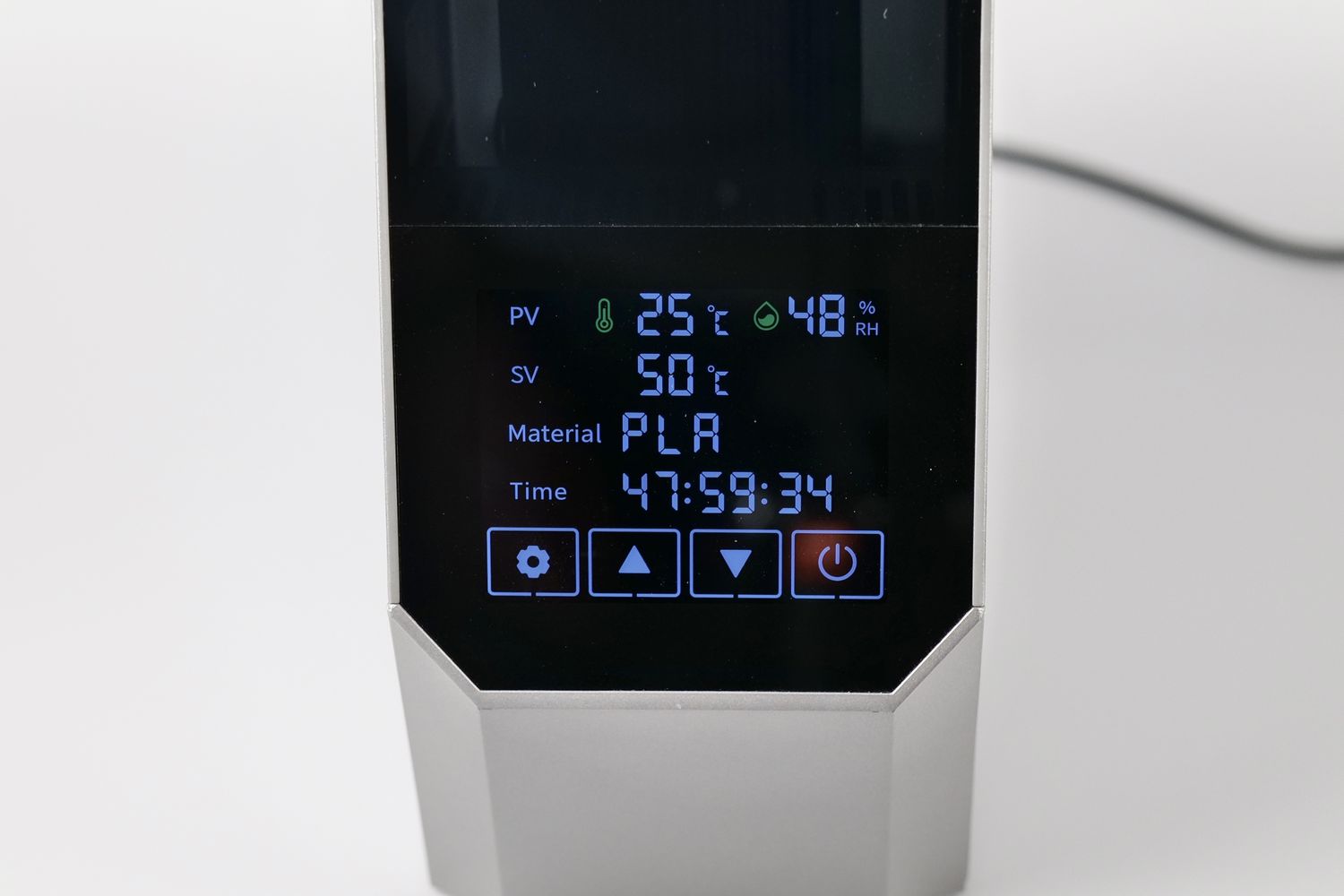
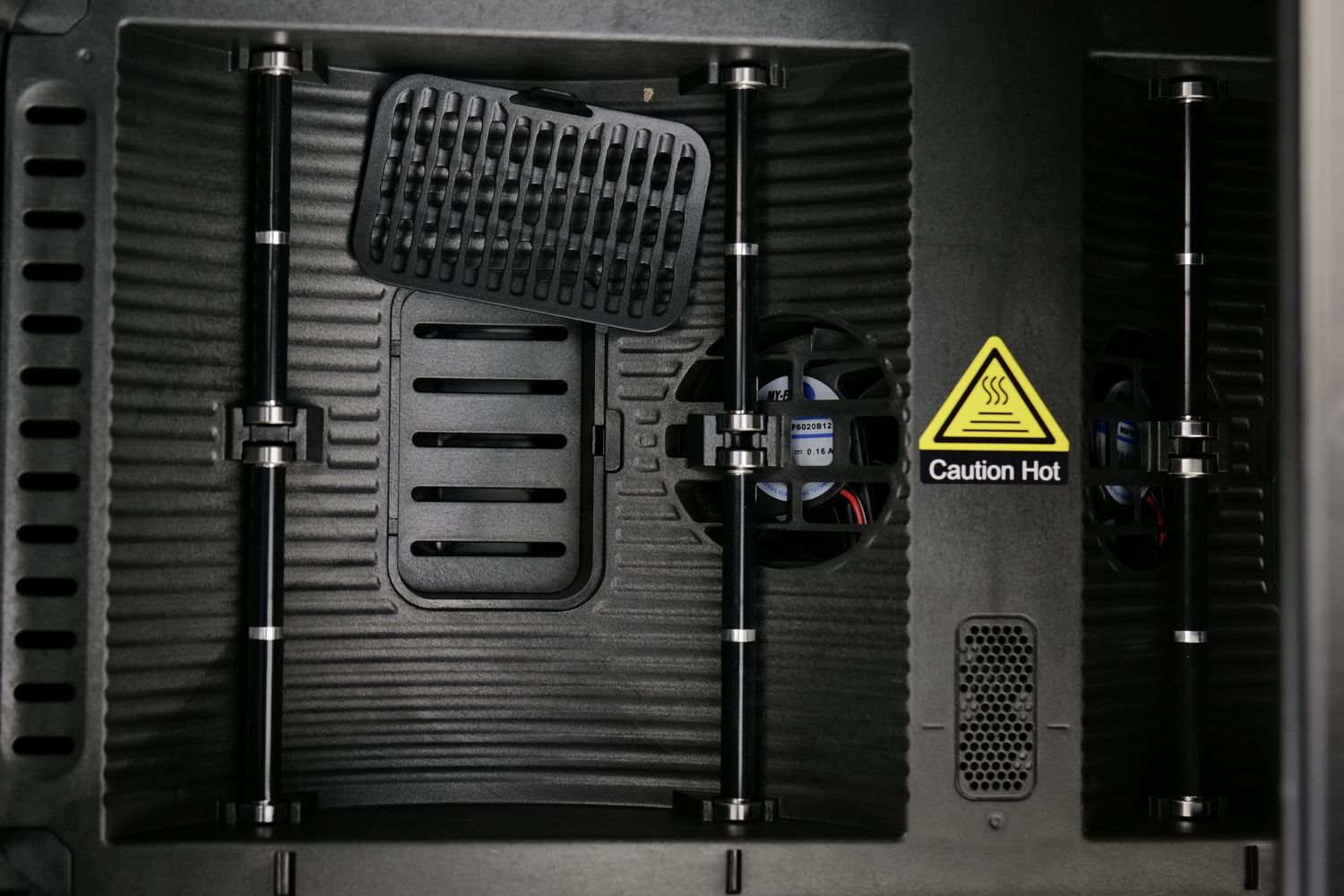
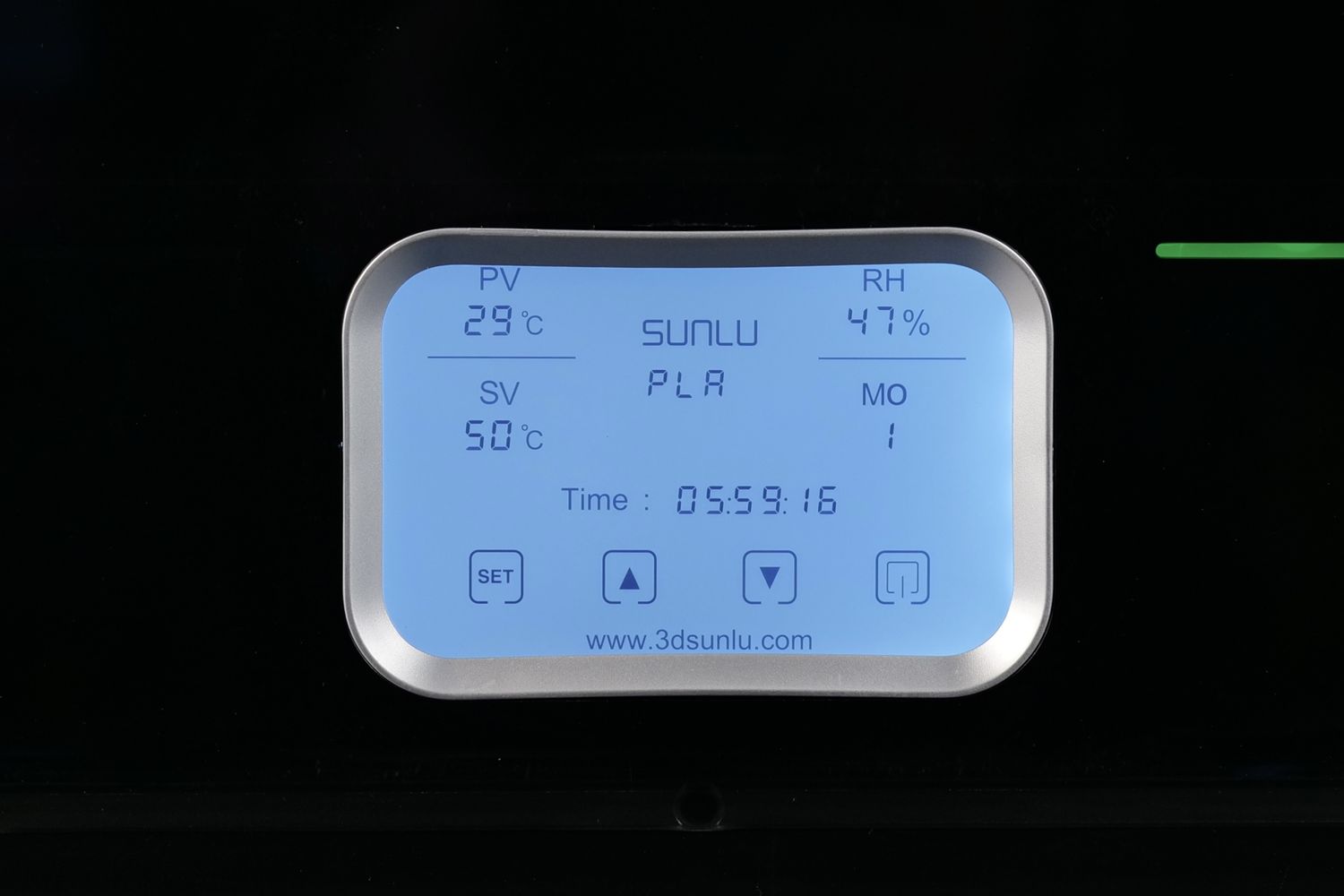
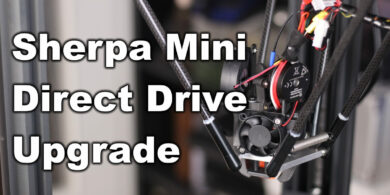

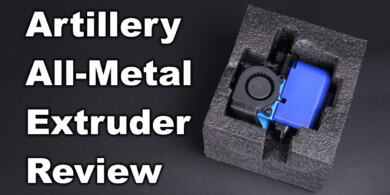

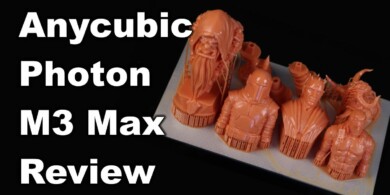
You can leave a comment for this article on the 3DPrintBeginner Forum